Trunkey Creek Wines Audit Program: An Audit Theory and Practice Report
VerifiedAdded on 2023/06/07
|20
|4625
|496
Report
AI Summary
This report details an audit program for Trunkey Creek Wines (TCW), a client of Miller Yates Howarth (MYH). It includes a business risk evaluation using liquidity, solvency, efficiency, and profitability ratios. Weaknesses in TCW's internal control systems for accounts payable and purchases are iden...

Running head: AUDITING THEORY AND PRACTICE
Auditing theory and practice
Name of the University
Name of the student
Authors note
Auditing theory and practice
Name of the University
Name of the student
Authors note
Paraphrase This Document
Need a fresh take? Get an instant paraphrase of this document with our AI Paraphraser
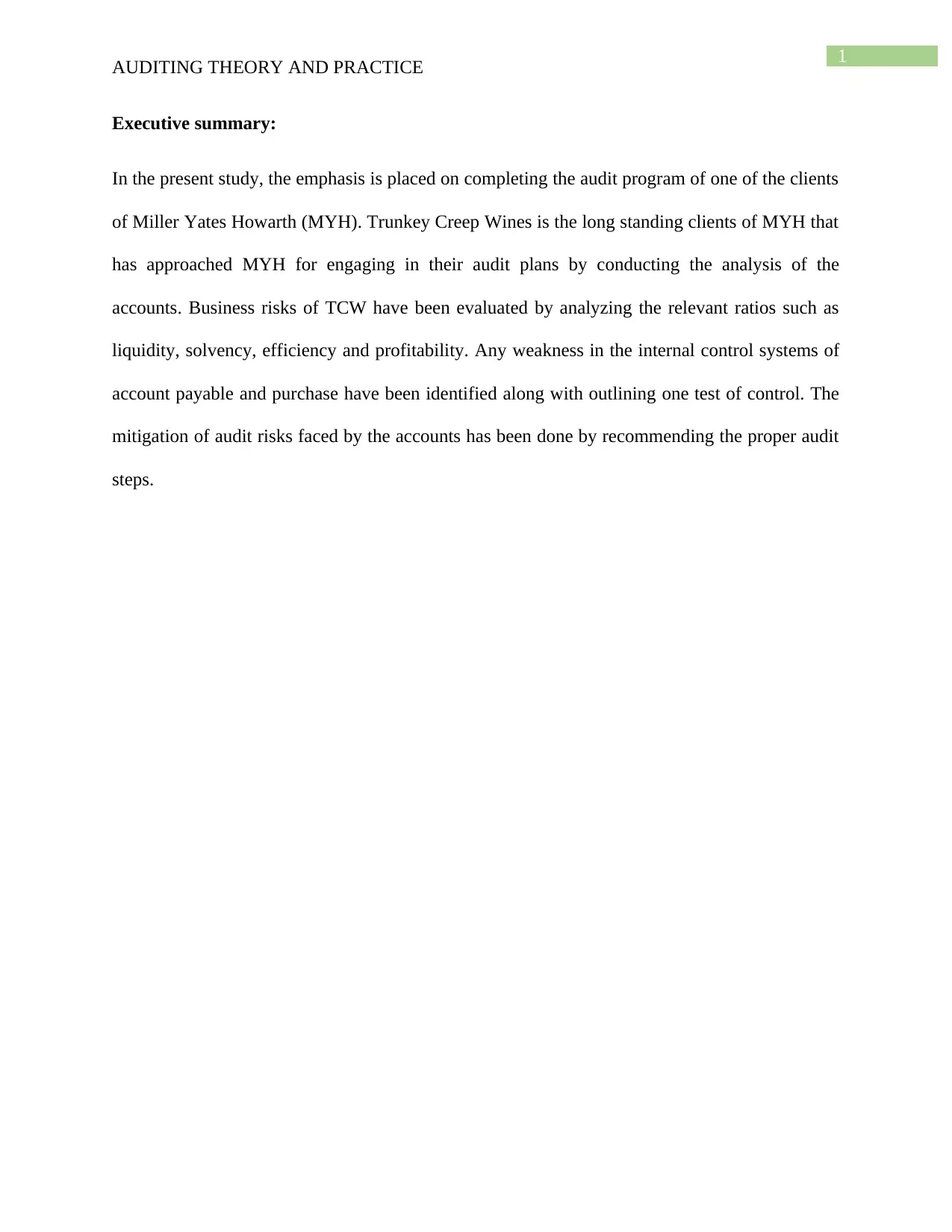
1
AUDITING THEORY AND PRACTICE
Executive summary:
In the present study, the emphasis is placed on completing the audit program of one of the clients
of Miller Yates Howarth (MYH). Trunkey Creep Wines is the long standing clients of MYH that
has approached MYH for engaging in their audit plans by conducting the analysis of the
accounts. Business risks of TCW have been evaluated by analyzing the relevant ratios such as
liquidity, solvency, efficiency and profitability. Any weakness in the internal control systems of
account payable and purchase have been identified along with outlining one test of control. The
mitigation of audit risks faced by the accounts has been done by recommending the proper audit
steps.
AUDITING THEORY AND PRACTICE
Executive summary:
In the present study, the emphasis is placed on completing the audit program of one of the clients
of Miller Yates Howarth (MYH). Trunkey Creep Wines is the long standing clients of MYH that
has approached MYH for engaging in their audit plans by conducting the analysis of the
accounts. Business risks of TCW have been evaluated by analyzing the relevant ratios such as
liquidity, solvency, efficiency and profitability. Any weakness in the internal control systems of
account payable and purchase have been identified along with outlining one test of control. The
mitigation of audit risks faced by the accounts has been done by recommending the proper audit
steps.
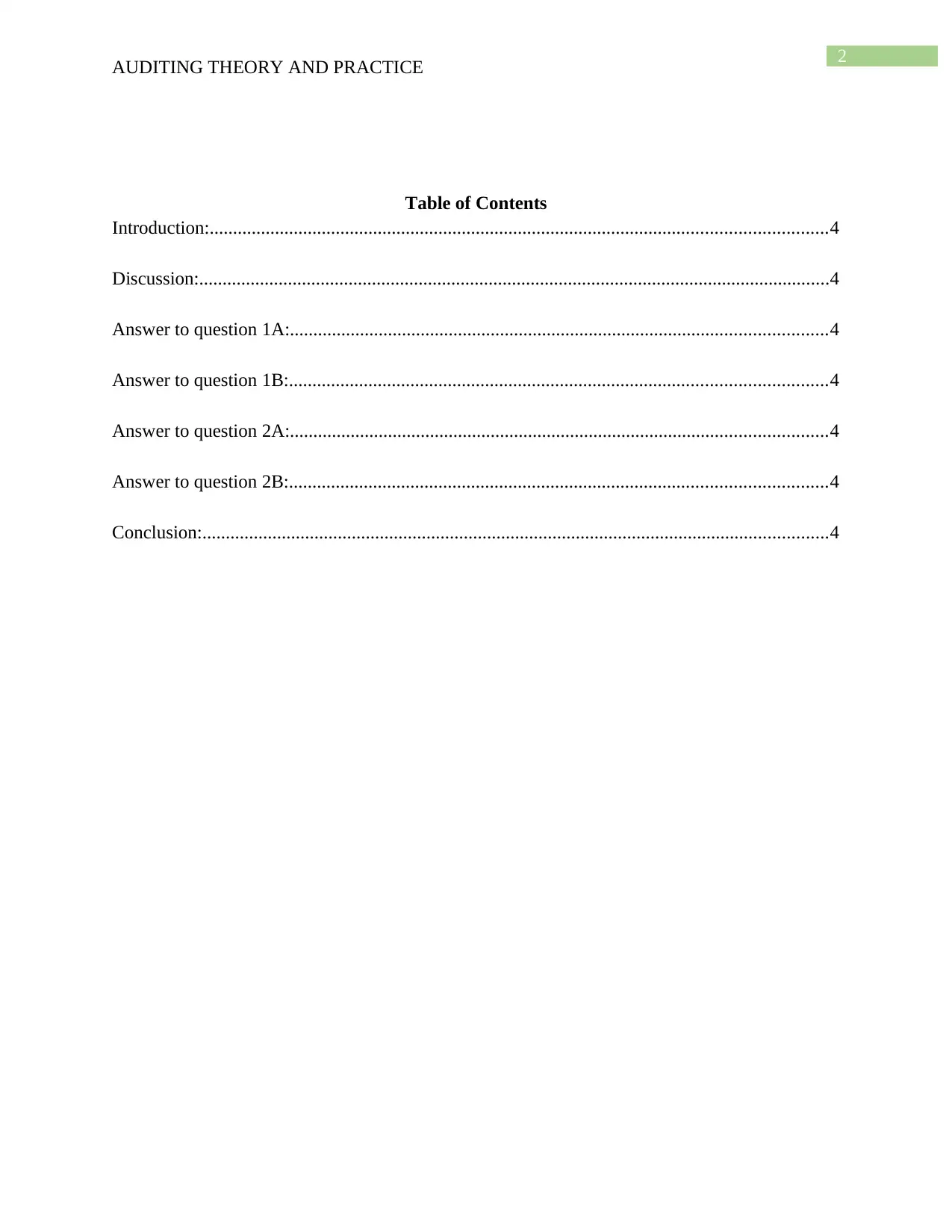
2
AUDITING THEORY AND PRACTICE
Table of Contents
Introduction:....................................................................................................................................4
Discussion:.......................................................................................................................................4
Answer to question 1A:...................................................................................................................4
Answer to question 1B:...................................................................................................................4
Answer to question 2A:...................................................................................................................4
Answer to question 2B:...................................................................................................................4
Conclusion:......................................................................................................................................4
AUDITING THEORY AND PRACTICE
Table of Contents
Introduction:....................................................................................................................................4
Discussion:.......................................................................................................................................4
Answer to question 1A:...................................................................................................................4
Answer to question 1B:...................................................................................................................4
Answer to question 2A:...................................................................................................................4
Answer to question 2B:...................................................................................................................4
Conclusion:......................................................................................................................................4
You're viewing a preview
Unlock full access by subscribing today!
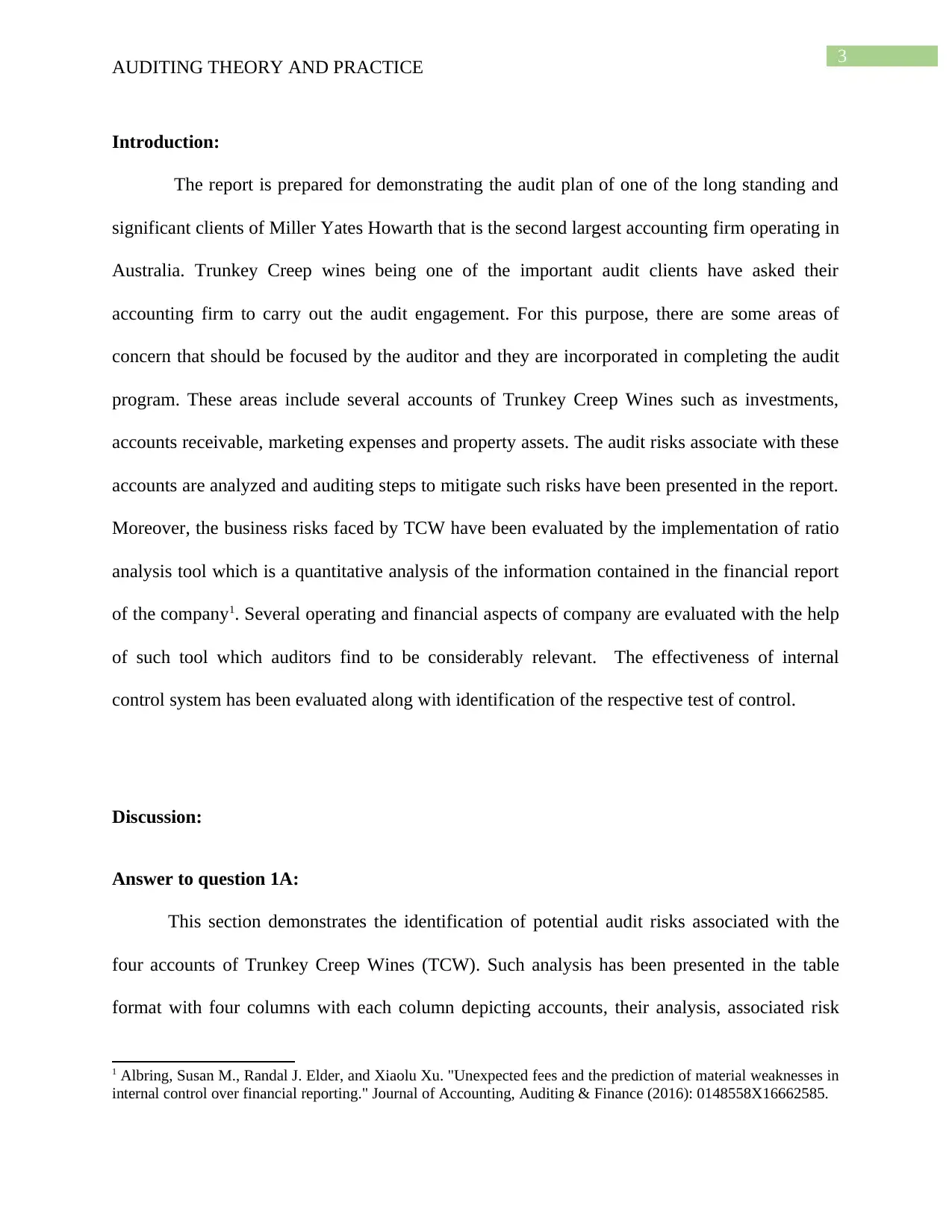
3
AUDITING THEORY AND PRACTICE
Introduction:
The report is prepared for demonstrating the audit plan of one of the long standing and
significant clients of Miller Yates Howarth that is the second largest accounting firm operating in
Australia. Trunkey Creep wines being one of the important audit clients have asked their
accounting firm to carry out the audit engagement. For this purpose, there are some areas of
concern that should be focused by the auditor and they are incorporated in completing the audit
program. These areas include several accounts of Trunkey Creep Wines such as investments,
accounts receivable, marketing expenses and property assets. The audit risks associate with these
accounts are analyzed and auditing steps to mitigate such risks have been presented in the report.
Moreover, the business risks faced by TCW have been evaluated by the implementation of ratio
analysis tool which is a quantitative analysis of the information contained in the financial report
of the company1. Several operating and financial aspects of company are evaluated with the help
of such tool which auditors find to be considerably relevant. The effectiveness of internal
control system has been evaluated along with identification of the respective test of control.
Discussion:
Answer to question 1A:
This section demonstrates the identification of potential audit risks associated with the
four accounts of Trunkey Creep Wines (TCW). Such analysis has been presented in the table
format with four columns with each column depicting accounts, their analysis, associated risk
1 Albring, Susan M., Randal J. Elder, and Xiaolu Xu. "Unexpected fees and the prediction of material weaknesses in
internal control over financial reporting." Journal of Accounting, Auditing & Finance (2016): 0148558X16662585.
AUDITING THEORY AND PRACTICE
Introduction:
The report is prepared for demonstrating the audit plan of one of the long standing and
significant clients of Miller Yates Howarth that is the second largest accounting firm operating in
Australia. Trunkey Creep wines being one of the important audit clients have asked their
accounting firm to carry out the audit engagement. For this purpose, there are some areas of
concern that should be focused by the auditor and they are incorporated in completing the audit
program. These areas include several accounts of Trunkey Creep Wines such as investments,
accounts receivable, marketing expenses and property assets. The audit risks associate with these
accounts are analyzed and auditing steps to mitigate such risks have been presented in the report.
Moreover, the business risks faced by TCW have been evaluated by the implementation of ratio
analysis tool which is a quantitative analysis of the information contained in the financial report
of the company1. Several operating and financial aspects of company are evaluated with the help
of such tool which auditors find to be considerably relevant. The effectiveness of internal
control system has been evaluated along with identification of the respective test of control.
Discussion:
Answer to question 1A:
This section demonstrates the identification of potential audit risks associated with the
four accounts of Trunkey Creep Wines (TCW). Such analysis has been presented in the table
format with four columns with each column depicting accounts, their analysis, associated risk
1 Albring, Susan M., Randal J. Elder, and Xiaolu Xu. "Unexpected fees and the prediction of material weaknesses in
internal control over financial reporting." Journal of Accounting, Auditing & Finance (2016): 0148558X16662585.
Paraphrase This Document
Need a fresh take? Get an instant paraphrase of this document with our AI Paraphraser
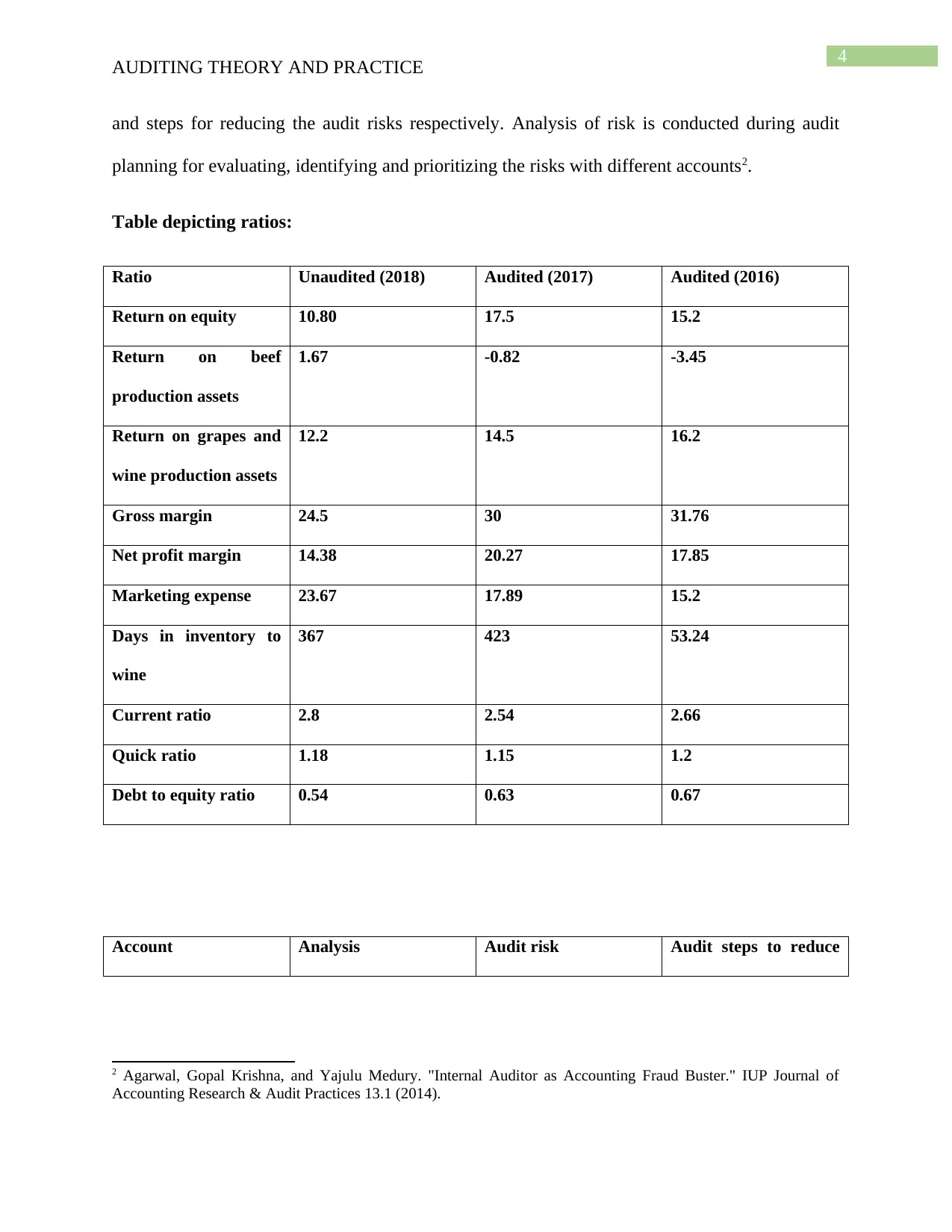
4
AUDITING THEORY AND PRACTICE
and steps for reducing the audit risks respectively. Analysis of risk is conducted during audit
planning for evaluating, identifying and prioritizing the risks with different accounts2.
Table depicting ratios:
Ratio Unaudited (2018) Audited (2017) Audited (2016)
Return on equity 10.80 17.5 15.2
Return on beef
production assets
1.67 -0.82 -3.45
Return on grapes and
wine production assets
12.2 14.5 16.2
Gross margin 24.5 30 31.76
Net profit margin 14.38 20.27 17.85
Marketing expense 23.67 17.89 15.2
Days in inventory to
wine
367 423 53.24
Current ratio 2.8 2.54 2.66
Quick ratio 1.18 1.15 1.2
Debt to equity ratio 0.54 0.63 0.67
Account Analysis Audit risk Audit steps to reduce
2 Agarwal, Gopal Krishna, and Yajulu Medury. "Internal Auditor as Accounting Fraud Buster." IUP Journal of
Accounting Research & Audit Practices 13.1 (2014).
AUDITING THEORY AND PRACTICE
and steps for reducing the audit risks respectively. Analysis of risk is conducted during audit
planning for evaluating, identifying and prioritizing the risks with different accounts2.
Table depicting ratios:
Ratio Unaudited (2018) Audited (2017) Audited (2016)
Return on equity 10.80 17.5 15.2
Return on beef
production assets
1.67 -0.82 -3.45
Return on grapes and
wine production assets
12.2 14.5 16.2
Gross margin 24.5 30 31.76
Net profit margin 14.38 20.27 17.85
Marketing expense 23.67 17.89 15.2
Days in inventory to
wine
367 423 53.24
Current ratio 2.8 2.54 2.66
Quick ratio 1.18 1.15 1.2
Debt to equity ratio 0.54 0.63 0.67
Account Analysis Audit risk Audit steps to reduce
2 Agarwal, Gopal Krishna, and Yajulu Medury. "Internal Auditor as Accounting Fraud Buster." IUP Journal of
Accounting Research & Audit Practices 13.1 (2014).
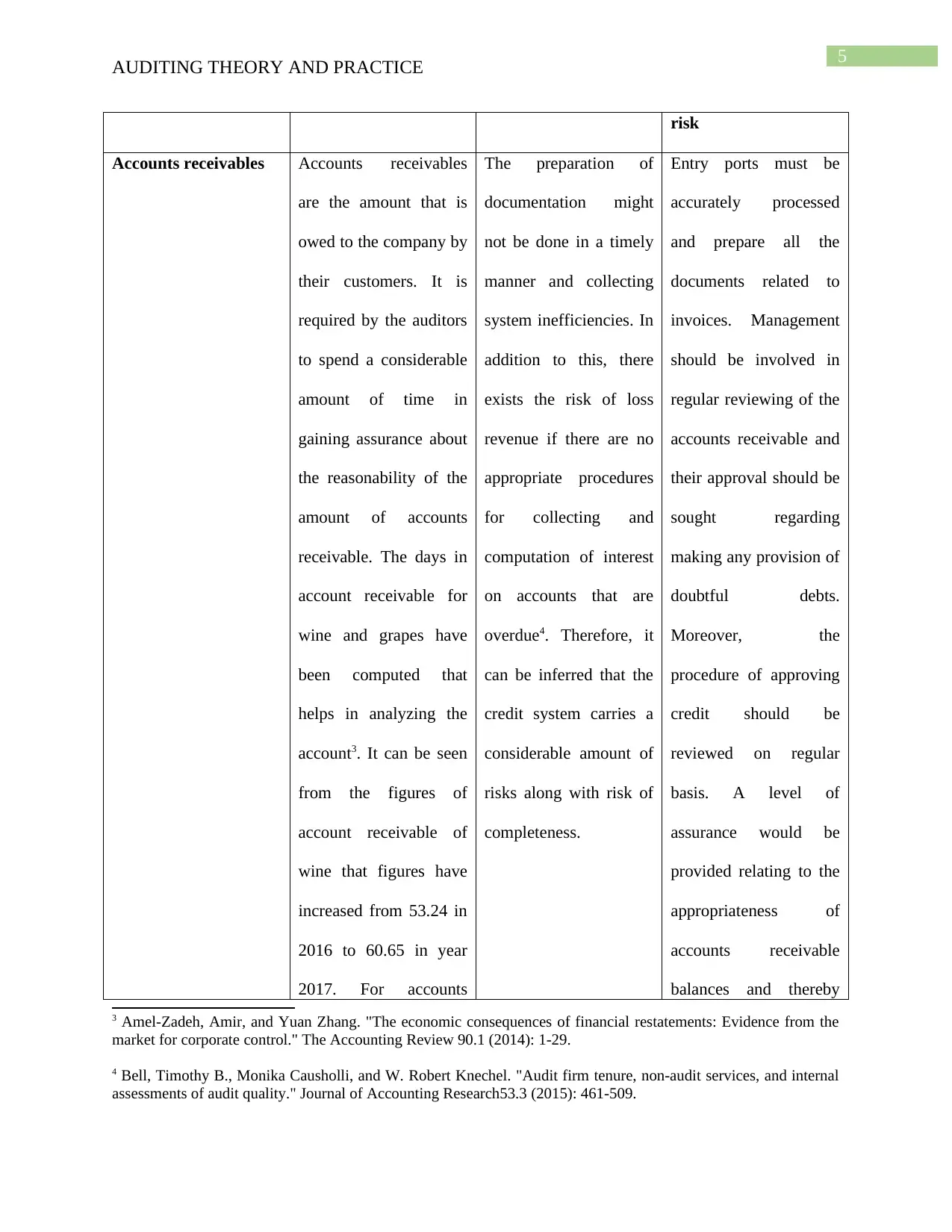
5
AUDITING THEORY AND PRACTICE
risk
Accounts receivables Accounts receivables
are the amount that is
owed to the company by
their customers. It is
required by the auditors
to spend a considerable
amount of time in
gaining assurance about
the reasonability of the
amount of accounts
receivable. The days in
account receivable for
wine and grapes have
been computed that
helps in analyzing the
account3. It can be seen
from the figures of
account receivable of
wine that figures have
increased from 53.24 in
2016 to 60.65 in year
2017. For accounts
The preparation of
documentation might
not be done in a timely
manner and collecting
system inefficiencies. In
addition to this, there
exists the risk of loss
revenue if there are no
appropriate procedures
for collecting and
computation of interest
on accounts that are
overdue4. Therefore, it
can be inferred that the
credit system carries a
considerable amount of
risks along with risk of
completeness.
Entry ports must be
accurately processed
and prepare all the
documents related to
invoices. Management
should be involved in
regular reviewing of the
accounts receivable and
their approval should be
sought regarding
making any provision of
doubtful debts.
Moreover, the
procedure of approving
credit should be
reviewed on regular
basis. A level of
assurance would be
provided relating to the
appropriateness of
accounts receivable
balances and thereby
3 Amel-Zadeh, Amir, and Yuan Zhang. "The economic consequences of financial restatements: Evidence from the
market for corporate control." The Accounting Review 90.1 (2014): 1-29.
4 Bell, Timothy B., Monika Causholli, and W. Robert Knechel. "Audit firm tenure, non‐audit services, and internal
assessments of audit quality." Journal of Accounting Research53.3 (2015): 461-509.
AUDITING THEORY AND PRACTICE
risk
Accounts receivables Accounts receivables
are the amount that is
owed to the company by
their customers. It is
required by the auditors
to spend a considerable
amount of time in
gaining assurance about
the reasonability of the
amount of accounts
receivable. The days in
account receivable for
wine and grapes have
been computed that
helps in analyzing the
account3. It can be seen
from the figures of
account receivable of
wine that figures have
increased from 53.24 in
2016 to 60.65 in year
2017. For accounts
The preparation of
documentation might
not be done in a timely
manner and collecting
system inefficiencies. In
addition to this, there
exists the risk of loss
revenue if there are no
appropriate procedures
for collecting and
computation of interest
on accounts that are
overdue4. Therefore, it
can be inferred that the
credit system carries a
considerable amount of
risks along with risk of
completeness.
Entry ports must be
accurately processed
and prepare all the
documents related to
invoices. Management
should be involved in
regular reviewing of the
accounts receivable and
their approval should be
sought regarding
making any provision of
doubtful debts.
Moreover, the
procedure of approving
credit should be
reviewed on regular
basis. A level of
assurance would be
provided relating to the
appropriateness of
accounts receivable
balances and thereby
3 Amel-Zadeh, Amir, and Yuan Zhang. "The economic consequences of financial restatements: Evidence from the
market for corporate control." The Accounting Review 90.1 (2014): 1-29.
4 Bell, Timothy B., Monika Causholli, and W. Robert Knechel. "Audit firm tenure, non‐audit services, and internal
assessments of audit quality." Journal of Accounting Research53.3 (2015): 461-509.
You're viewing a preview
Unlock full access by subscribing today!
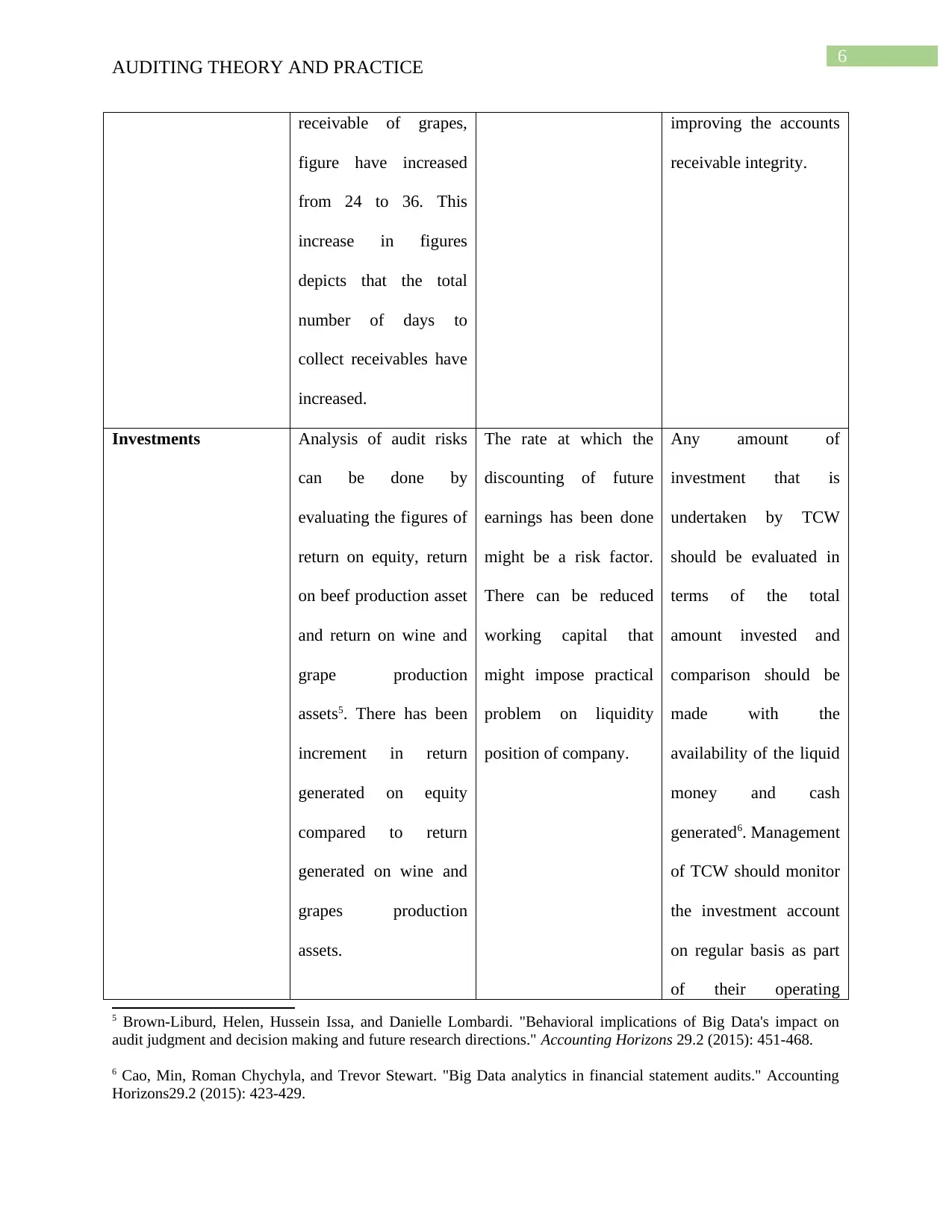
6
AUDITING THEORY AND PRACTICE
receivable of grapes,
figure have increased
from 24 to 36. This
increase in figures
depicts that the total
number of days to
collect receivables have
increased.
improving the accounts
receivable integrity.
Investments Analysis of audit risks
can be done by
evaluating the figures of
return on equity, return
on beef production asset
and return on wine and
grape production
assets5. There has been
increment in return
generated on equity
compared to return
generated on wine and
grapes production
assets.
The rate at which the
discounting of future
earnings has been done
might be a risk factor.
There can be reduced
working capital that
might impose practical
problem on liquidity
position of company.
Any amount of
investment that is
undertaken by TCW
should be evaluated in
terms of the total
amount invested and
comparison should be
made with the
availability of the liquid
money and cash
generated6. Management
of TCW should monitor
the investment account
on regular basis as part
of their operating
5 Brown-Liburd, Helen, Hussein Issa, and Danielle Lombardi. "Behavioral implications of Big Data's impact on
audit judgment and decision making and future research directions." Accounting Horizons 29.2 (2015): 451-468.
6 Cao, Min, Roman Chychyla, and Trevor Stewart. "Big Data analytics in financial statement audits." Accounting
Horizons29.2 (2015): 423-429.
AUDITING THEORY AND PRACTICE
receivable of grapes,
figure have increased
from 24 to 36. This
increase in figures
depicts that the total
number of days to
collect receivables have
increased.
improving the accounts
receivable integrity.
Investments Analysis of audit risks
can be done by
evaluating the figures of
return on equity, return
on beef production asset
and return on wine and
grape production
assets5. There has been
increment in return
generated on equity
compared to return
generated on wine and
grapes production
assets.
The rate at which the
discounting of future
earnings has been done
might be a risk factor.
There can be reduced
working capital that
might impose practical
problem on liquidity
position of company.
Any amount of
investment that is
undertaken by TCW
should be evaluated in
terms of the total
amount invested and
comparison should be
made with the
availability of the liquid
money and cash
generated6. Management
of TCW should monitor
the investment account
on regular basis as part
of their operating
5 Brown-Liburd, Helen, Hussein Issa, and Danielle Lombardi. "Behavioral implications of Big Data's impact on
audit judgment and decision making and future research directions." Accounting Horizons 29.2 (2015): 451-468.
6 Cao, Min, Roman Chychyla, and Trevor Stewart. "Big Data analytics in financial statement audits." Accounting
Horizons29.2 (2015): 423-429.
Paraphrase This Document
Need a fresh take? Get an instant paraphrase of this document with our AI Paraphraser
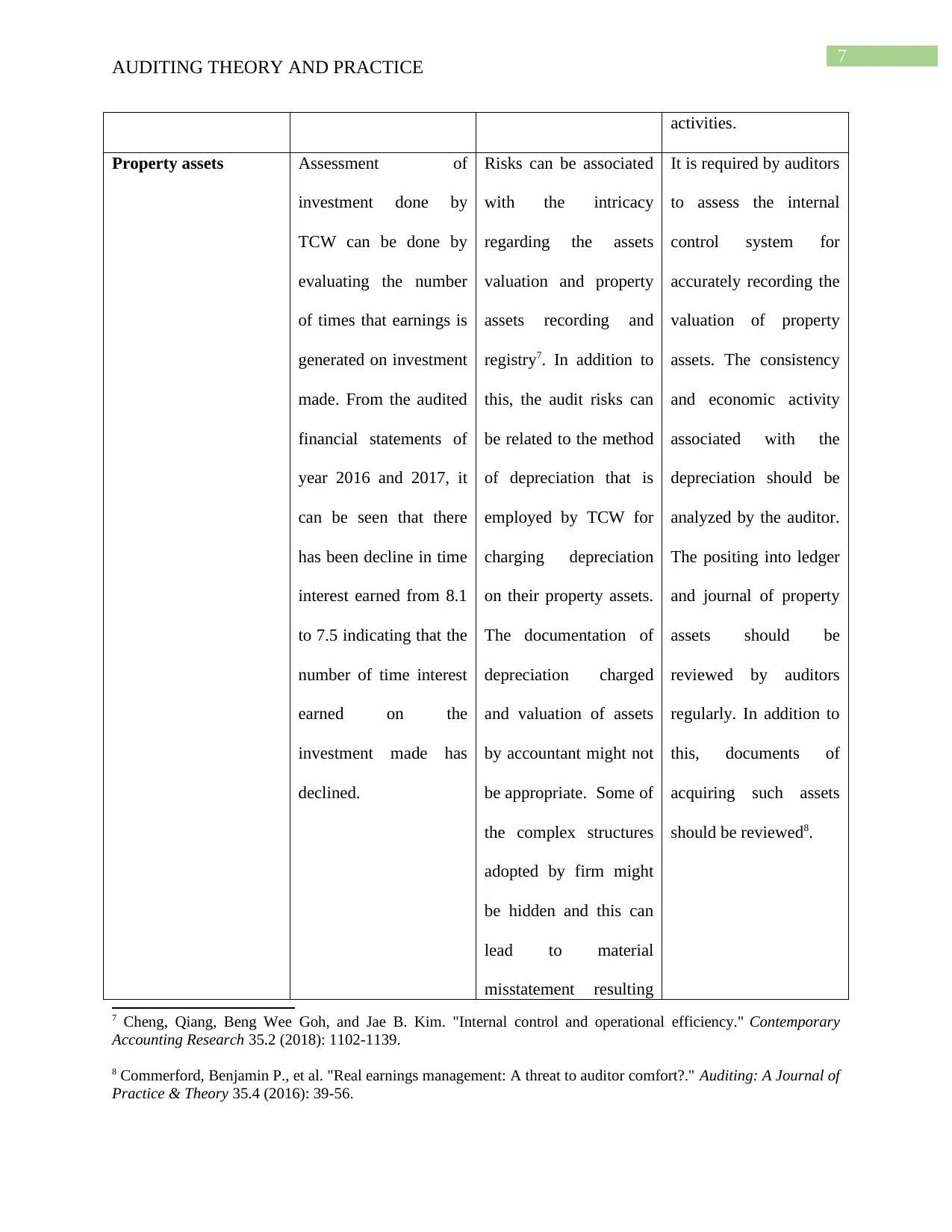
7
AUDITING THEORY AND PRACTICE
activities.
Property assets Assessment of
investment done by
TCW can be done by
evaluating the number
of times that earnings is
generated on investment
made. From the audited
financial statements of
year 2016 and 2017, it
can be seen that there
has been decline in time
interest earned from 8.1
to 7.5 indicating that the
number of time interest
earned on the
investment made has
declined.
Risks can be associated
with the intricacy
regarding the assets
valuation and property
assets recording and
registry7. In addition to
this, the audit risks can
be related to the method
of depreciation that is
employed by TCW for
charging depreciation
on their property assets.
The documentation of
depreciation charged
and valuation of assets
by accountant might not
be appropriate. Some of
the complex structures
adopted by firm might
be hidden and this can
lead to material
misstatement resulting
It is required by auditors
to assess the internal
control system for
accurately recording the
valuation of property
assets. The consistency
and economic activity
associated with the
depreciation should be
analyzed by the auditor.
The positing into ledger
and journal of property
assets should be
reviewed by auditors
regularly. In addition to
this, documents of
acquiring such assets
should be reviewed8.
7 Cheng, Qiang, Beng Wee Goh, and Jae B. Kim. "Internal control and operational efficiency." Contemporary
Accounting Research 35.2 (2018): 1102-1139.
8 Commerford, Benjamin P., et al. "Real earnings management: A threat to auditor comfort?." Auditing: A Journal of
Practice & Theory 35.4 (2016): 39-56.
AUDITING THEORY AND PRACTICE
activities.
Property assets Assessment of
investment done by
TCW can be done by
evaluating the number
of times that earnings is
generated on investment
made. From the audited
financial statements of
year 2016 and 2017, it
can be seen that there
has been decline in time
interest earned from 8.1
to 7.5 indicating that the
number of time interest
earned on the
investment made has
declined.
Risks can be associated
with the intricacy
regarding the assets
valuation and property
assets recording and
registry7. In addition to
this, the audit risks can
be related to the method
of depreciation that is
employed by TCW for
charging depreciation
on their property assets.
The documentation of
depreciation charged
and valuation of assets
by accountant might not
be appropriate. Some of
the complex structures
adopted by firm might
be hidden and this can
lead to material
misstatement resulting
It is required by auditors
to assess the internal
control system for
accurately recording the
valuation of property
assets. The consistency
and economic activity
associated with the
depreciation should be
analyzed by the auditor.
The positing into ledger
and journal of property
assets should be
reviewed by auditors
regularly. In addition to
this, documents of
acquiring such assets
should be reviewed8.
7 Cheng, Qiang, Beng Wee Goh, and Jae B. Kim. "Internal control and operational efficiency." Contemporary
Accounting Research 35.2 (2018): 1102-1139.
8 Commerford, Benjamin P., et al. "Real earnings management: A threat to auditor comfort?." Auditing: A Journal of
Practice & Theory 35.4 (2016): 39-56.
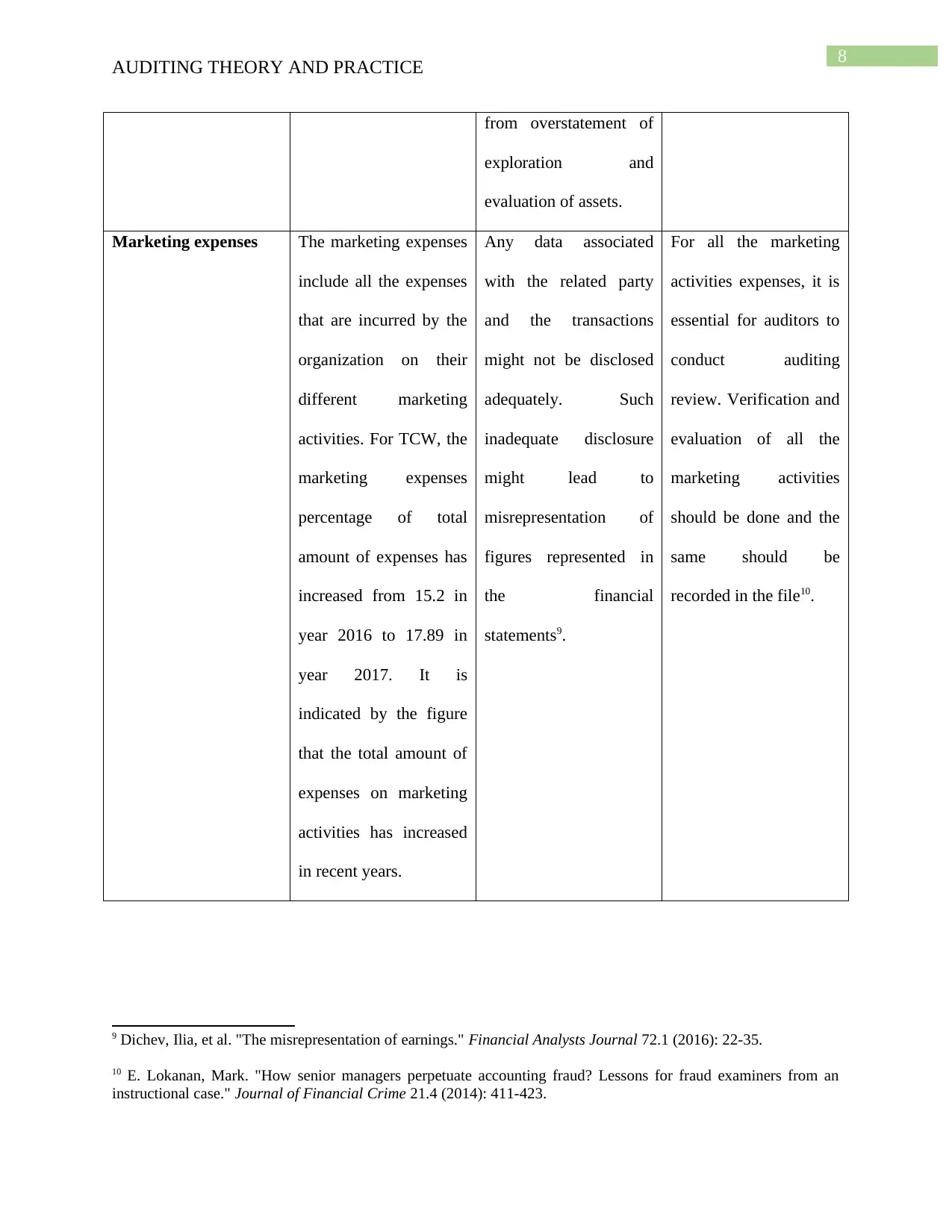
8
AUDITING THEORY AND PRACTICE
from overstatement of
exploration and
evaluation of assets.
Marketing expenses The marketing expenses
include all the expenses
that are incurred by the
organization on their
different marketing
activities. For TCW, the
marketing expenses
percentage of total
amount of expenses has
increased from 15.2 in
year 2016 to 17.89 in
year 2017. It is
indicated by the figure
that the total amount of
expenses on marketing
activities has increased
in recent years.
Any data associated
with the related party
and the transactions
might not be disclosed
adequately. Such
inadequate disclosure
might lead to
misrepresentation of
figures represented in
the financial
statements9.
For all the marketing
activities expenses, it is
essential for auditors to
conduct auditing
review. Verification and
evaluation of all the
marketing activities
should be done and the
same should be
recorded in the file10.
9 Dichev, Ilia, et al. "The misrepresentation of earnings." Financial Analysts Journal 72.1 (2016): 22-35.
10 E. Lokanan, Mark. "How senior managers perpetuate accounting fraud? Lessons for fraud examiners from an
instructional case." Journal of Financial Crime 21.4 (2014): 411-423.
AUDITING THEORY AND PRACTICE
from overstatement of
exploration and
evaluation of assets.
Marketing expenses The marketing expenses
include all the expenses
that are incurred by the
organization on their
different marketing
activities. For TCW, the
marketing expenses
percentage of total
amount of expenses has
increased from 15.2 in
year 2016 to 17.89 in
year 2017. It is
indicated by the figure
that the total amount of
expenses on marketing
activities has increased
in recent years.
Any data associated
with the related party
and the transactions
might not be disclosed
adequately. Such
inadequate disclosure
might lead to
misrepresentation of
figures represented in
the financial
statements9.
For all the marketing
activities expenses, it is
essential for auditors to
conduct auditing
review. Verification and
evaluation of all the
marketing activities
should be done and the
same should be
recorded in the file10.
9 Dichev, Ilia, et al. "The misrepresentation of earnings." Financial Analysts Journal 72.1 (2016): 22-35.
10 E. Lokanan, Mark. "How senior managers perpetuate accounting fraud? Lessons for fraud examiners from an
instructional case." Journal of Financial Crime 21.4 (2014): 411-423.
You're viewing a preview
Unlock full access by subscribing today!
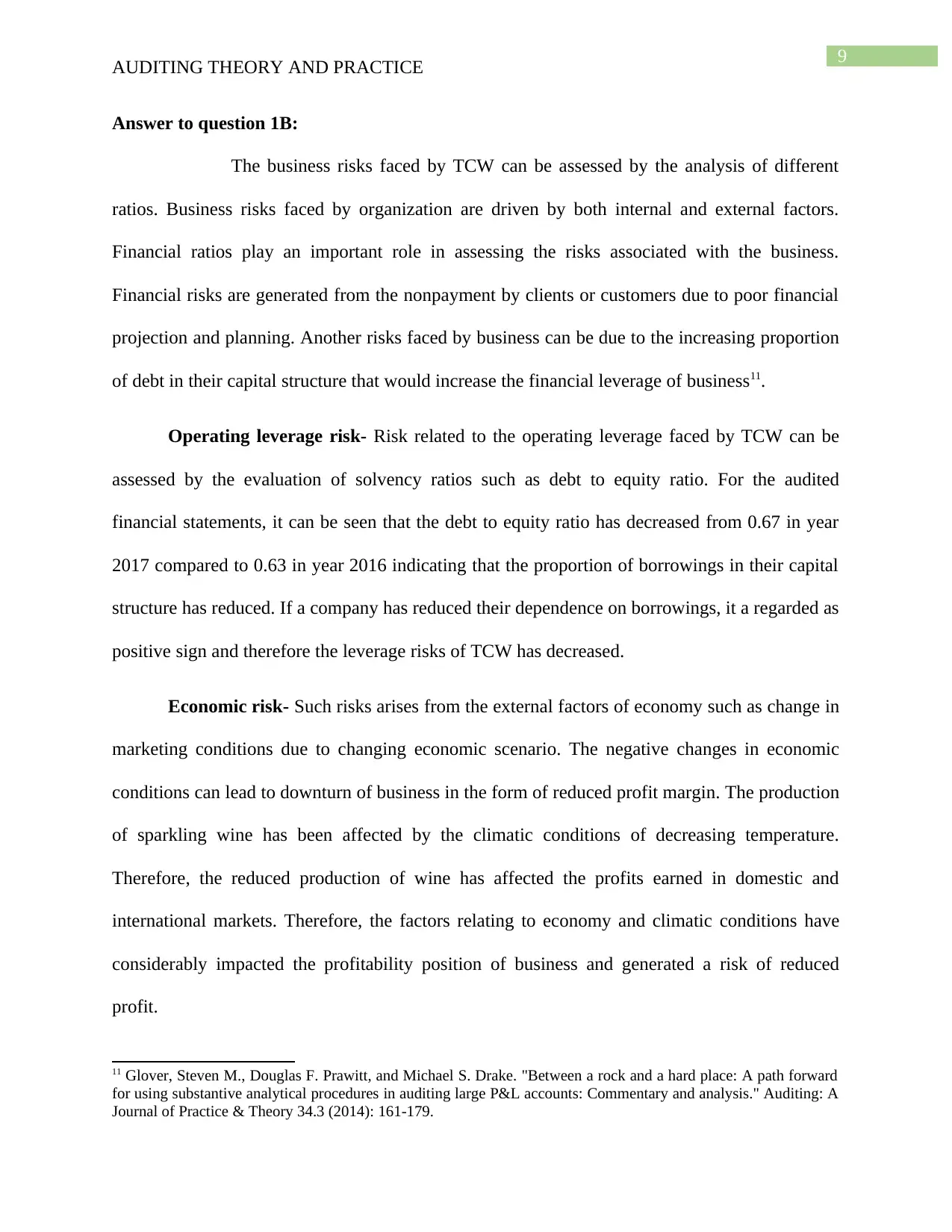
9
AUDITING THEORY AND PRACTICE
Answer to question 1B:
The business risks faced by TCW can be assessed by the analysis of different
ratios. Business risks faced by organization are driven by both internal and external factors.
Financial ratios play an important role in assessing the risks associated with the business.
Financial risks are generated from the nonpayment by clients or customers due to poor financial
projection and planning. Another risks faced by business can be due to the increasing proportion
of debt in their capital structure that would increase the financial leverage of business11.
Operating leverage risk- Risk related to the operating leverage faced by TCW can be
assessed by the evaluation of solvency ratios such as debt to equity ratio. For the audited
financial statements, it can be seen that the debt to equity ratio has decreased from 0.67 in year
2017 compared to 0.63 in year 2016 indicating that the proportion of borrowings in their capital
structure has reduced. If a company has reduced their dependence on borrowings, it a regarded as
positive sign and therefore the leverage risks of TCW has decreased.
Economic risk- Such risks arises from the external factors of economy such as change in
marketing conditions due to changing economic scenario. The negative changes in economic
conditions can lead to downturn of business in the form of reduced profit margin. The production
of sparkling wine has been affected by the climatic conditions of decreasing temperature.
Therefore, the reduced production of wine has affected the profits earned in domestic and
international markets. Therefore, the factors relating to economy and climatic conditions have
considerably impacted the profitability position of business and generated a risk of reduced
profit.
11 Glover, Steven M., Douglas F. Prawitt, and Michael S. Drake. "Between a rock and a hard place: A path forward
for using substantive analytical procedures in auditing large P&L accounts: Commentary and analysis." Auditing: A
Journal of Practice & Theory 34.3 (2014): 161-179.
AUDITING THEORY AND PRACTICE
Answer to question 1B:
The business risks faced by TCW can be assessed by the analysis of different
ratios. Business risks faced by organization are driven by both internal and external factors.
Financial ratios play an important role in assessing the risks associated with the business.
Financial risks are generated from the nonpayment by clients or customers due to poor financial
projection and planning. Another risks faced by business can be due to the increasing proportion
of debt in their capital structure that would increase the financial leverage of business11.
Operating leverage risk- Risk related to the operating leverage faced by TCW can be
assessed by the evaluation of solvency ratios such as debt to equity ratio. For the audited
financial statements, it can be seen that the debt to equity ratio has decreased from 0.67 in year
2017 compared to 0.63 in year 2016 indicating that the proportion of borrowings in their capital
structure has reduced. If a company has reduced their dependence on borrowings, it a regarded as
positive sign and therefore the leverage risks of TCW has decreased.
Economic risk- Such risks arises from the external factors of economy such as change in
marketing conditions due to changing economic scenario. The negative changes in economic
conditions can lead to downturn of business in the form of reduced profit margin. The production
of sparkling wine has been affected by the climatic conditions of decreasing temperature.
Therefore, the reduced production of wine has affected the profits earned in domestic and
international markets. Therefore, the factors relating to economy and climatic conditions have
considerably impacted the profitability position of business and generated a risk of reduced
profit.
11 Glover, Steven M., Douglas F. Prawitt, and Michael S. Drake. "Between a rock and a hard place: A path forward
for using substantive analytical procedures in auditing large P&L accounts: Commentary and analysis." Auditing: A
Journal of Practice & Theory 34.3 (2014): 161-179.
Paraphrase This Document
Need a fresh take? Get an instant paraphrase of this document with our AI Paraphraser
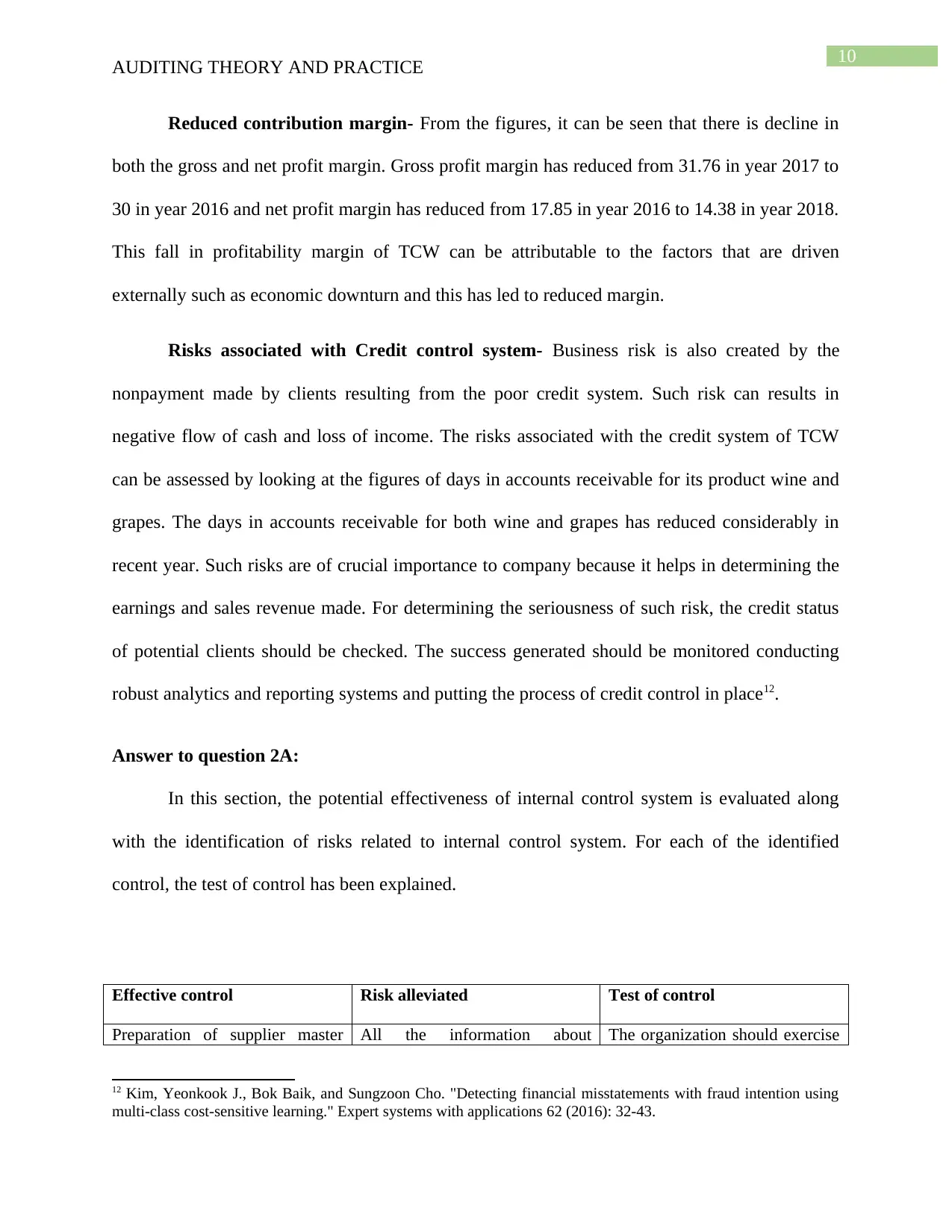
10
AUDITING THEORY AND PRACTICE
Reduced contribution margin- From the figures, it can be seen that there is decline in
both the gross and net profit margin. Gross profit margin has reduced from 31.76 in year 2017 to
30 in year 2016 and net profit margin has reduced from 17.85 in year 2016 to 14.38 in year 2018.
This fall in profitability margin of TCW can be attributable to the factors that are driven
externally such as economic downturn and this has led to reduced margin.
Risks associated with Credit control system- Business risk is also created by the
nonpayment made by clients resulting from the poor credit system. Such risk can results in
negative flow of cash and loss of income. The risks associated with the credit system of TCW
can be assessed by looking at the figures of days in accounts receivable for its product wine and
grapes. The days in accounts receivable for both wine and grapes has reduced considerably in
recent year. Such risks are of crucial importance to company because it helps in determining the
earnings and sales revenue made. For determining the seriousness of such risk, the credit status
of potential clients should be checked. The success generated should be monitored conducting
robust analytics and reporting systems and putting the process of credit control in place12.
Answer to question 2A:
In this section, the potential effectiveness of internal control system is evaluated along
with the identification of risks related to internal control system. For each of the identified
control, the test of control has been explained.
Effective control Risk alleviated Test of control
Preparation of supplier master All the information about The organization should exercise
12 Kim, Yeonkook J., Bok Baik, and Sungzoon Cho. "Detecting financial misstatements with fraud intention using
multi-class cost-sensitive learning." Expert systems with applications 62 (2016): 32-43.
AUDITING THEORY AND PRACTICE
Reduced contribution margin- From the figures, it can be seen that there is decline in
both the gross and net profit margin. Gross profit margin has reduced from 31.76 in year 2017 to
30 in year 2016 and net profit margin has reduced from 17.85 in year 2016 to 14.38 in year 2018.
This fall in profitability margin of TCW can be attributable to the factors that are driven
externally such as economic downturn and this has led to reduced margin.
Risks associated with Credit control system- Business risk is also created by the
nonpayment made by clients resulting from the poor credit system. Such risk can results in
negative flow of cash and loss of income. The risks associated with the credit system of TCW
can be assessed by looking at the figures of days in accounts receivable for its product wine and
grapes. The days in accounts receivable for both wine and grapes has reduced considerably in
recent year. Such risks are of crucial importance to company because it helps in determining the
earnings and sales revenue made. For determining the seriousness of such risk, the credit status
of potential clients should be checked. The success generated should be monitored conducting
robust analytics and reporting systems and putting the process of credit control in place12.
Answer to question 2A:
In this section, the potential effectiveness of internal control system is evaluated along
with the identification of risks related to internal control system. For each of the identified
control, the test of control has been explained.
Effective control Risk alleviated Test of control
Preparation of supplier master All the information about The organization should exercise
12 Kim, Yeonkook J., Bok Baik, and Sungzoon Cho. "Detecting financial misstatements with fraud intention using
multi-class cost-sensitive learning." Expert systems with applications 62 (2016): 32-43.
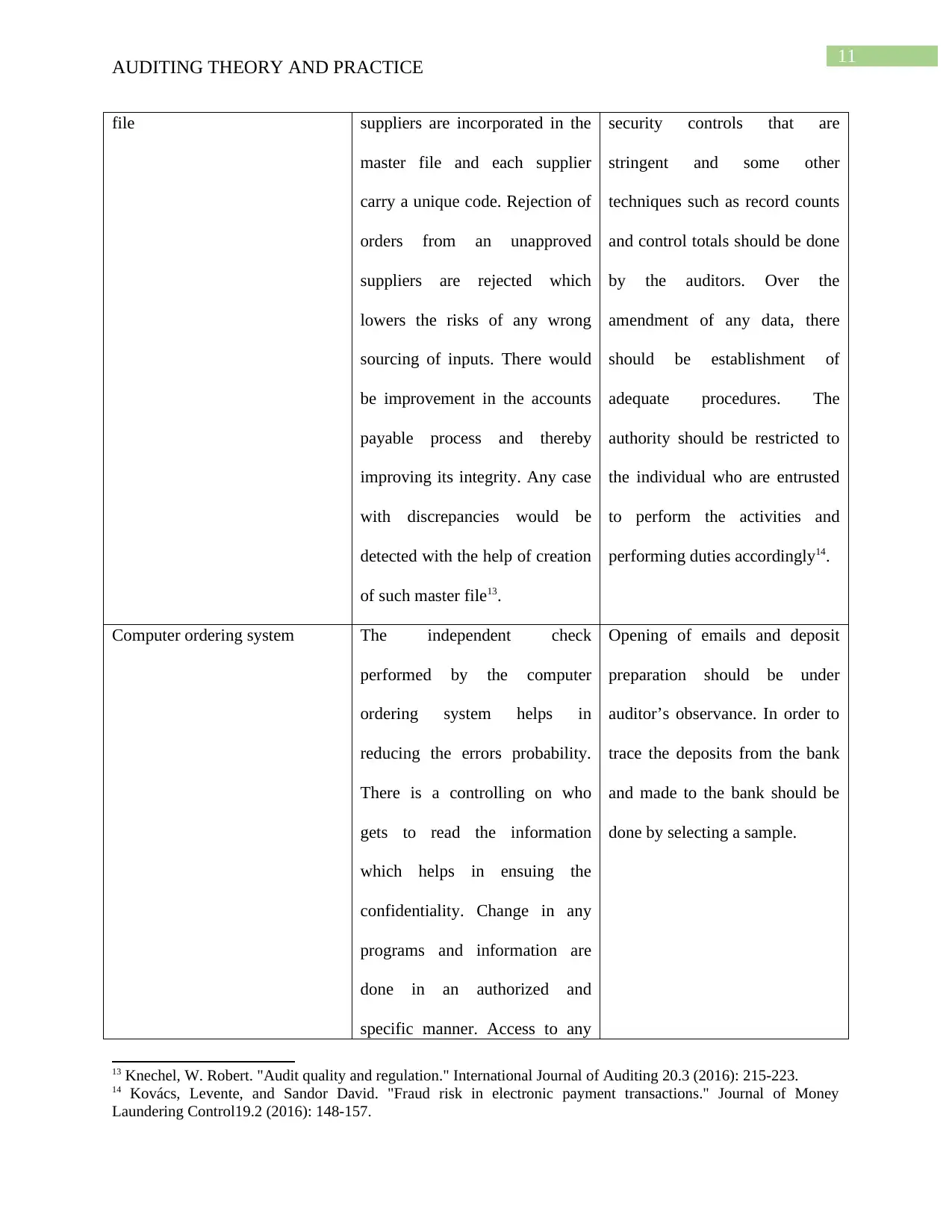
11
AUDITING THEORY AND PRACTICE
file suppliers are incorporated in the
master file and each supplier
carry a unique code. Rejection of
orders from an unapproved
suppliers are rejected which
lowers the risks of any wrong
sourcing of inputs. There would
be improvement in the accounts
payable process and thereby
improving its integrity. Any case
with discrepancies would be
detected with the help of creation
of such master file13.
security controls that are
stringent and some other
techniques such as record counts
and control totals should be done
by the auditors. Over the
amendment of any data, there
should be establishment of
adequate procedures. The
authority should be restricted to
the individual who are entrusted
to perform the activities and
performing duties accordingly14.
Computer ordering system The independent check
performed by the computer
ordering system helps in
reducing the errors probability.
There is a controlling on who
gets to read the information
which helps in ensuing the
confidentiality. Change in any
programs and information are
done in an authorized and
specific manner. Access to any
Opening of emails and deposit
preparation should be under
auditor’s observance. In order to
trace the deposits from the bank
and made to the bank should be
done by selecting a sample.
13 Knechel, W. Robert. "Audit quality and regulation." International Journal of Auditing 20.3 (2016): 215-223.
14 Kovács, Levente, and Sandor David. "Fraud risk in electronic payment transactions." Journal of Money
Laundering Control19.2 (2016): 148-157.
AUDITING THEORY AND PRACTICE
file suppliers are incorporated in the
master file and each supplier
carry a unique code. Rejection of
orders from an unapproved
suppliers are rejected which
lowers the risks of any wrong
sourcing of inputs. There would
be improvement in the accounts
payable process and thereby
improving its integrity. Any case
with discrepancies would be
detected with the help of creation
of such master file13.
security controls that are
stringent and some other
techniques such as record counts
and control totals should be done
by the auditors. Over the
amendment of any data, there
should be establishment of
adequate procedures. The
authority should be restricted to
the individual who are entrusted
to perform the activities and
performing duties accordingly14.
Computer ordering system The independent check
performed by the computer
ordering system helps in
reducing the errors probability.
There is a controlling on who
gets to read the information
which helps in ensuing the
confidentiality. Change in any
programs and information are
done in an authorized and
specific manner. Access to any
Opening of emails and deposit
preparation should be under
auditor’s observance. In order to
trace the deposits from the bank
and made to the bank should be
done by selecting a sample.
13 Knechel, W. Robert. "Audit quality and regulation." International Journal of Auditing 20.3 (2016): 215-223.
14 Kovács, Levente, and Sandor David. "Fraud risk in electronic payment transactions." Journal of Money
Laundering Control19.2 (2016): 148-157.
You're viewing a preview
Unlock full access by subscribing today!
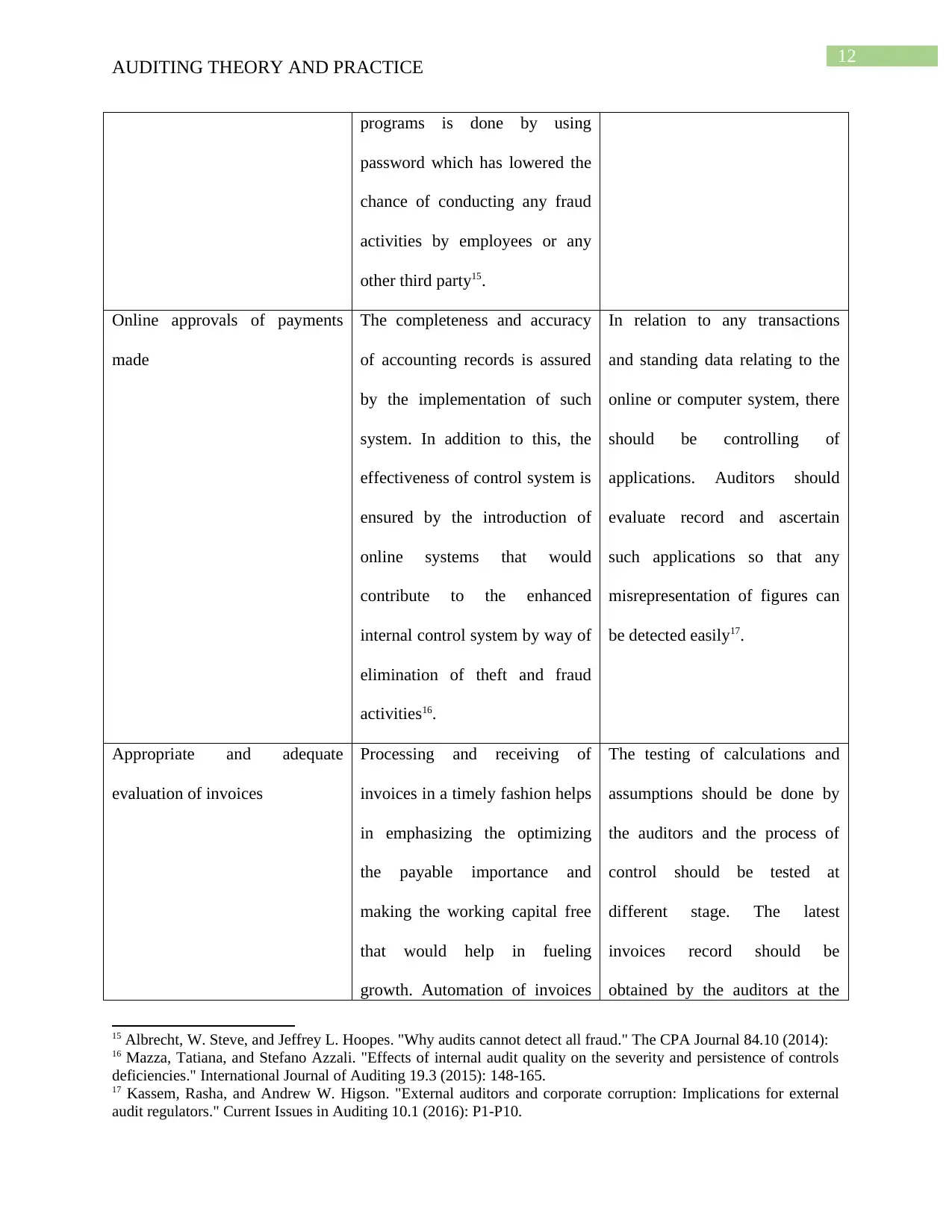
12
AUDITING THEORY AND PRACTICE
programs is done by using
password which has lowered the
chance of conducting any fraud
activities by employees or any
other third party15.
Online approvals of payments
made
The completeness and accuracy
of accounting records is assured
by the implementation of such
system. In addition to this, the
effectiveness of control system is
ensured by the introduction of
online systems that would
contribute to the enhanced
internal control system by way of
elimination of theft and fraud
activities16.
In relation to any transactions
and standing data relating to the
online or computer system, there
should be controlling of
applications. Auditors should
evaluate record and ascertain
such applications so that any
misrepresentation of figures can
be detected easily17.
Appropriate and adequate
evaluation of invoices
Processing and receiving of
invoices in a timely fashion helps
in emphasizing the optimizing
the payable importance and
making the working capital free
that would help in fueling
growth. Automation of invoices
The testing of calculations and
assumptions should be done by
the auditors and the process of
control should be tested at
different stage. The latest
invoices record should be
obtained by the auditors at the
15 Albrecht, W. Steve, and Jeffrey L. Hoopes. "Why audits cannot detect all fraud." The CPA Journal 84.10 (2014):
16 Mazza, Tatiana, and Stefano Azzali. "Effects of internal audit quality on the severity and persistence of controls
deficiencies." International Journal of Auditing 19.3 (2015): 148-165.
17 Kassem, Rasha, and Andrew W. Higson. "External auditors and corporate corruption: Implications for external
audit regulators." Current Issues in Auditing 10.1 (2016): P1-P10.
AUDITING THEORY AND PRACTICE
programs is done by using
password which has lowered the
chance of conducting any fraud
activities by employees or any
other third party15.
Online approvals of payments
made
The completeness and accuracy
of accounting records is assured
by the implementation of such
system. In addition to this, the
effectiveness of control system is
ensured by the introduction of
online systems that would
contribute to the enhanced
internal control system by way of
elimination of theft and fraud
activities16.
In relation to any transactions
and standing data relating to the
online or computer system, there
should be controlling of
applications. Auditors should
evaluate record and ascertain
such applications so that any
misrepresentation of figures can
be detected easily17.
Appropriate and adequate
evaluation of invoices
Processing and receiving of
invoices in a timely fashion helps
in emphasizing the optimizing
the payable importance and
making the working capital free
that would help in fueling
growth. Automation of invoices
The testing of calculations and
assumptions should be done by
the auditors and the process of
control should be tested at
different stage. The latest
invoices record should be
obtained by the auditors at the
15 Albrecht, W. Steve, and Jeffrey L. Hoopes. "Why audits cannot detect all fraud." The CPA Journal 84.10 (2014):
16 Mazza, Tatiana, and Stefano Azzali. "Effects of internal audit quality on the severity and persistence of controls
deficiencies." International Journal of Auditing 19.3 (2015): 148-165.
17 Kassem, Rasha, and Andrew W. Higson. "External auditors and corporate corruption: Implications for external
audit regulators." Current Issues in Auditing 10.1 (2016): P1-P10.
Paraphrase This Document
Need a fresh take? Get an instant paraphrase of this document with our AI Paraphraser
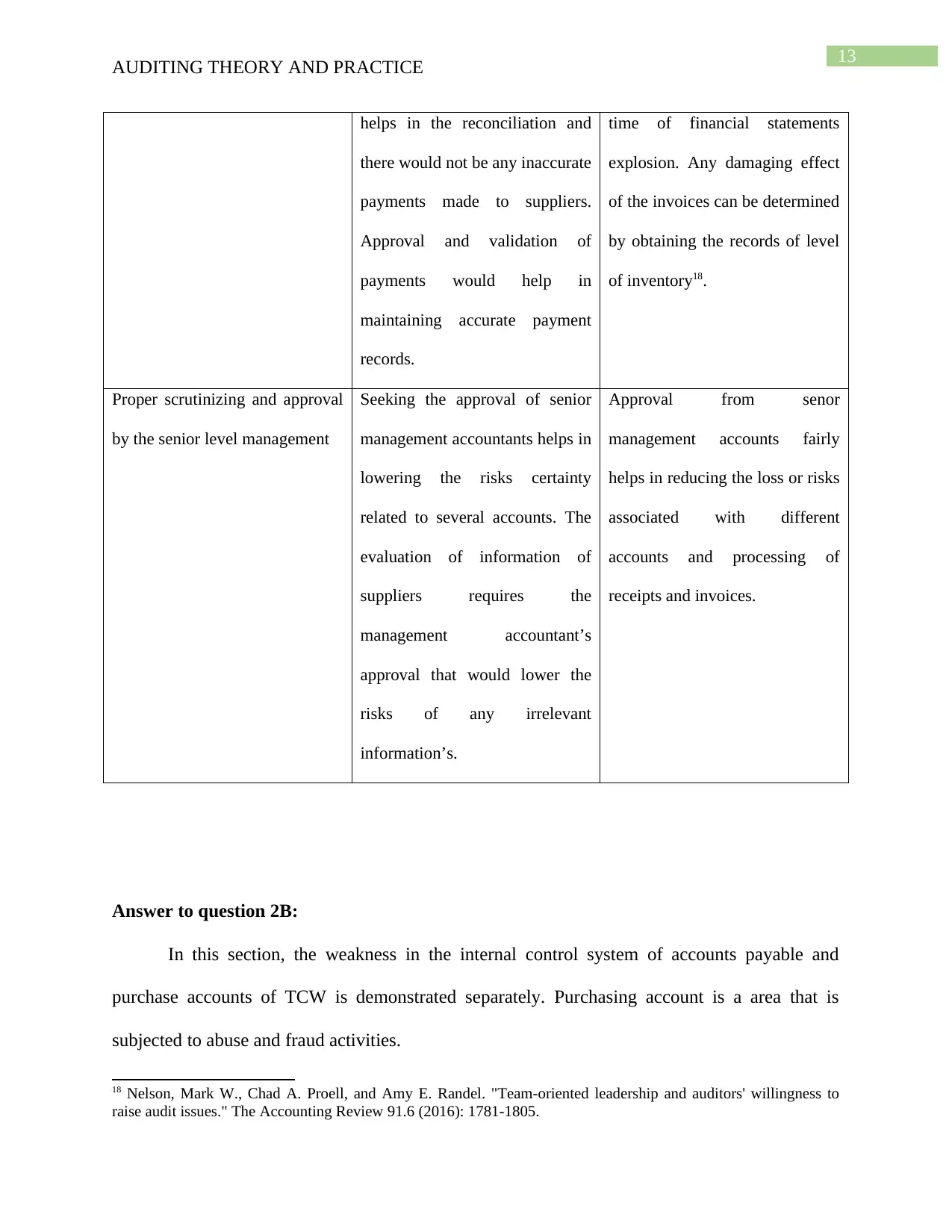
13
AUDITING THEORY AND PRACTICE
helps in the reconciliation and
there would not be any inaccurate
payments made to suppliers.
Approval and validation of
payments would help in
maintaining accurate payment
records.
time of financial statements
explosion. Any damaging effect
of the invoices can be determined
by obtaining the records of level
of inventory18.
Proper scrutinizing and approval
by the senior level management
Seeking the approval of senior
management accountants helps in
lowering the risks certainty
related to several accounts. The
evaluation of information of
suppliers requires the
management accountant’s
approval that would lower the
risks of any irrelevant
information’s.
Approval from senor
management accounts fairly
helps in reducing the loss or risks
associated with different
accounts and processing of
receipts and invoices.
Answer to question 2B:
In this section, the weakness in the internal control system of accounts payable and
purchase accounts of TCW is demonstrated separately. Purchasing account is a area that is
subjected to abuse and fraud activities.
18 Nelson, Mark W., Chad A. Proell, and Amy E. Randel. "Team-oriented leadership and auditors' willingness to
raise audit issues." The Accounting Review 91.6 (2016): 1781-1805.
AUDITING THEORY AND PRACTICE
helps in the reconciliation and
there would not be any inaccurate
payments made to suppliers.
Approval and validation of
payments would help in
maintaining accurate payment
records.
time of financial statements
explosion. Any damaging effect
of the invoices can be determined
by obtaining the records of level
of inventory18.
Proper scrutinizing and approval
by the senior level management
Seeking the approval of senior
management accountants helps in
lowering the risks certainty
related to several accounts. The
evaluation of information of
suppliers requires the
management accountant’s
approval that would lower the
risks of any irrelevant
information’s.
Approval from senor
management accounts fairly
helps in reducing the loss or risks
associated with different
accounts and processing of
receipts and invoices.
Answer to question 2B:
In this section, the weakness in the internal control system of accounts payable and
purchase accounts of TCW is demonstrated separately. Purchasing account is a area that is
subjected to abuse and fraud activities.
18 Nelson, Mark W., Chad A. Proell, and Amy E. Randel. "Team-oriented leadership and auditors' willingness to
raise audit issues." The Accounting Review 91.6 (2016): 1781-1805.
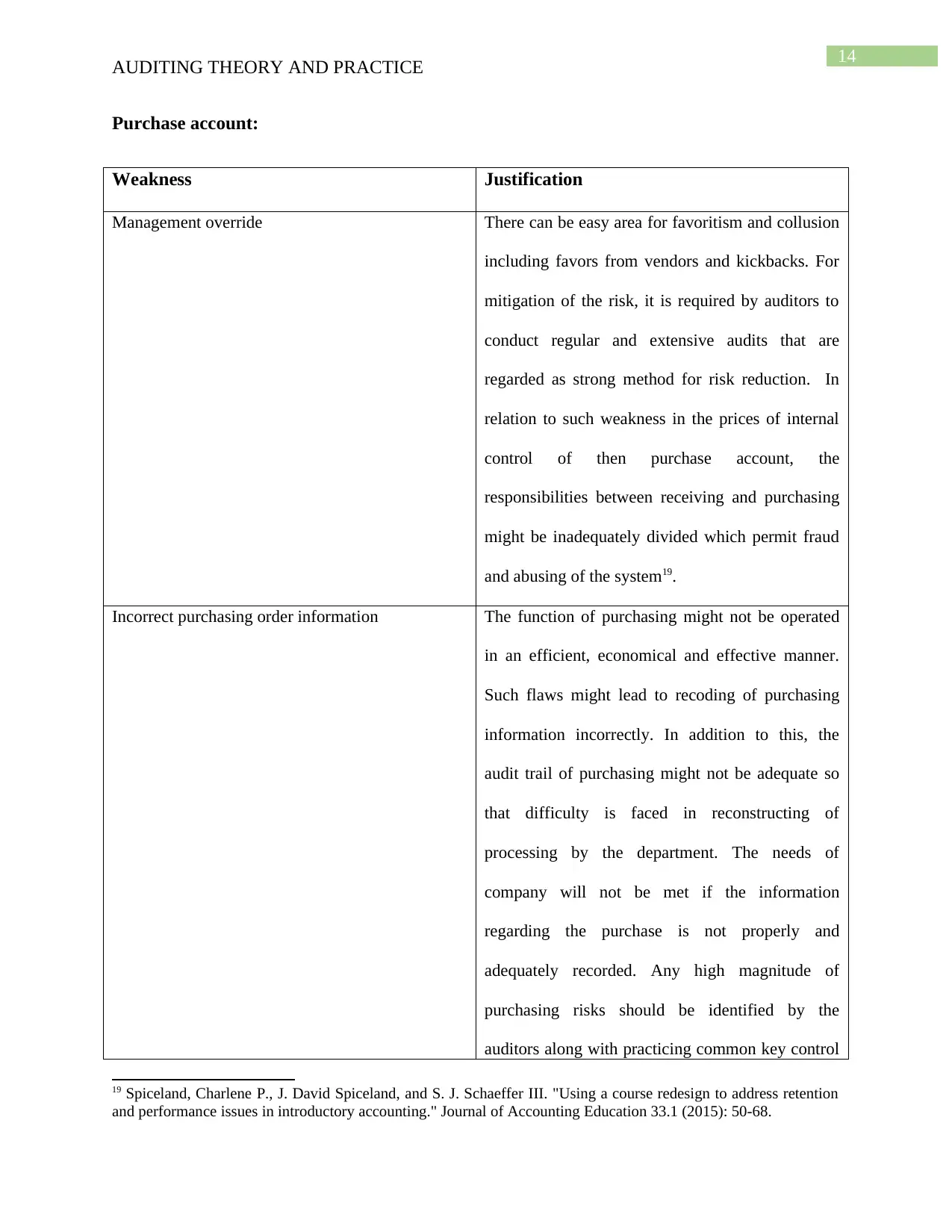
14
AUDITING THEORY AND PRACTICE
Purchase account:
Weakness Justification
Management override There can be easy area for favoritism and collusion
including favors from vendors and kickbacks. For
mitigation of the risk, it is required by auditors to
conduct regular and extensive audits that are
regarded as strong method for risk reduction. In
relation to such weakness in the prices of internal
control of then purchase account, the
responsibilities between receiving and purchasing
might be inadequately divided which permit fraud
and abusing of the system19.
Incorrect purchasing order information The function of purchasing might not be operated
in an efficient, economical and effective manner.
Such flaws might lead to recoding of purchasing
information incorrectly. In addition to this, the
audit trail of purchasing might not be adequate so
that difficulty is faced in reconstructing of
processing by the department. The needs of
company will not be met if the information
regarding the purchase is not properly and
adequately recorded. Any high magnitude of
purchasing risks should be identified by the
auditors along with practicing common key control
19 Spiceland, Charlene P., J. David Spiceland, and S. J. Schaeffer III. "Using a course redesign to address retention
and performance issues in introductory accounting." Journal of Accounting Education 33.1 (2015): 50-68.
AUDITING THEORY AND PRACTICE
Purchase account:
Weakness Justification
Management override There can be easy area for favoritism and collusion
including favors from vendors and kickbacks. For
mitigation of the risk, it is required by auditors to
conduct regular and extensive audits that are
regarded as strong method for risk reduction. In
relation to such weakness in the prices of internal
control of then purchase account, the
responsibilities between receiving and purchasing
might be inadequately divided which permit fraud
and abusing of the system19.
Incorrect purchasing order information The function of purchasing might not be operated
in an efficient, economical and effective manner.
Such flaws might lead to recoding of purchasing
information incorrectly. In addition to this, the
audit trail of purchasing might not be adequate so
that difficulty is faced in reconstructing of
processing by the department. The needs of
company will not be met if the information
regarding the purchase is not properly and
adequately recorded. Any high magnitude of
purchasing risks should be identified by the
auditors along with practicing common key control
19 Spiceland, Charlene P., J. David Spiceland, and S. J. Schaeffer III. "Using a course redesign to address retention
and performance issues in introductory accounting." Journal of Accounting Education 33.1 (2015): 50-68.
You're viewing a preview
Unlock full access by subscribing today!
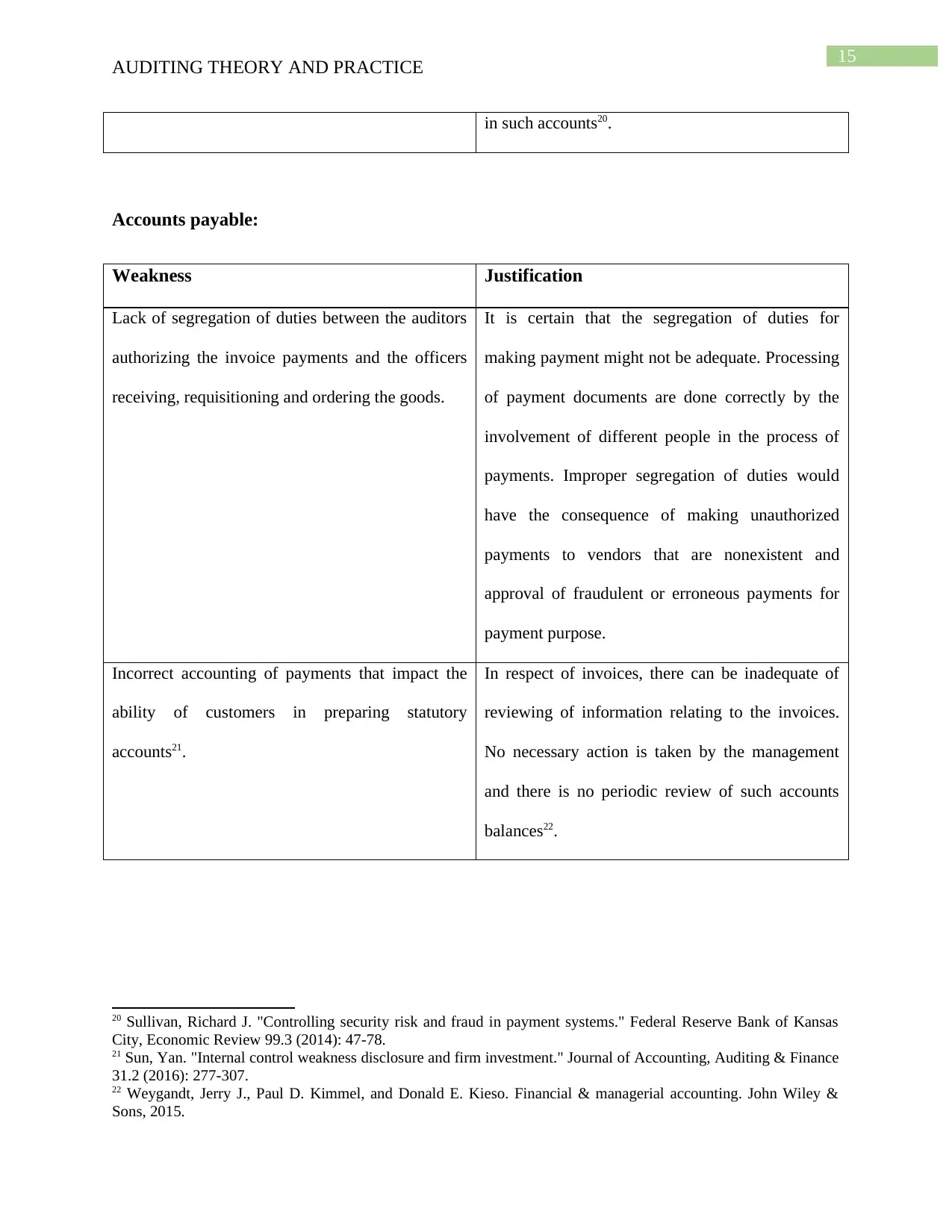
15
AUDITING THEORY AND PRACTICE
in such accounts20.
Accounts payable:
Weakness Justification
Lack of segregation of duties between the auditors
authorizing the invoice payments and the officers
receiving, requisitioning and ordering the goods.
It is certain that the segregation of duties for
making payment might not be adequate. Processing
of payment documents are done correctly by the
involvement of different people in the process of
payments. Improper segregation of duties would
have the consequence of making unauthorized
payments to vendors that are nonexistent and
approval of fraudulent or erroneous payments for
payment purpose.
Incorrect accounting of payments that impact the
ability of customers in preparing statutory
accounts21.
In respect of invoices, there can be inadequate of
reviewing of information relating to the invoices.
No necessary action is taken by the management
and there is no periodic review of such accounts
balances22.
20 Sullivan, Richard J. "Controlling security risk and fraud in payment systems." Federal Reserve Bank of Kansas
City, Economic Review 99.3 (2014): 47-78.
21 Sun, Yan. "Internal control weakness disclosure and firm investment." Journal of Accounting, Auditing & Finance
31.2 (2016): 277-307.
22 Weygandt, Jerry J., Paul D. Kimmel, and Donald E. Kieso. Financial & managerial accounting. John Wiley &
Sons, 2015.
AUDITING THEORY AND PRACTICE
in such accounts20.
Accounts payable:
Weakness Justification
Lack of segregation of duties between the auditors
authorizing the invoice payments and the officers
receiving, requisitioning and ordering the goods.
It is certain that the segregation of duties for
making payment might not be adequate. Processing
of payment documents are done correctly by the
involvement of different people in the process of
payments. Improper segregation of duties would
have the consequence of making unauthorized
payments to vendors that are nonexistent and
approval of fraudulent or erroneous payments for
payment purpose.
Incorrect accounting of payments that impact the
ability of customers in preparing statutory
accounts21.
In respect of invoices, there can be inadequate of
reviewing of information relating to the invoices.
No necessary action is taken by the management
and there is no periodic review of such accounts
balances22.
20 Sullivan, Richard J. "Controlling security risk and fraud in payment systems." Federal Reserve Bank of Kansas
City, Economic Review 99.3 (2014): 47-78.
21 Sun, Yan. "Internal control weakness disclosure and firm investment." Journal of Accounting, Auditing & Finance
31.2 (2016): 277-307.
22 Weygandt, Jerry J., Paul D. Kimmel, and Donald E. Kieso. Financial & managerial accounting. John Wiley &
Sons, 2015.
Paraphrase This Document
Need a fresh take? Get an instant paraphrase of this document with our AI Paraphraser
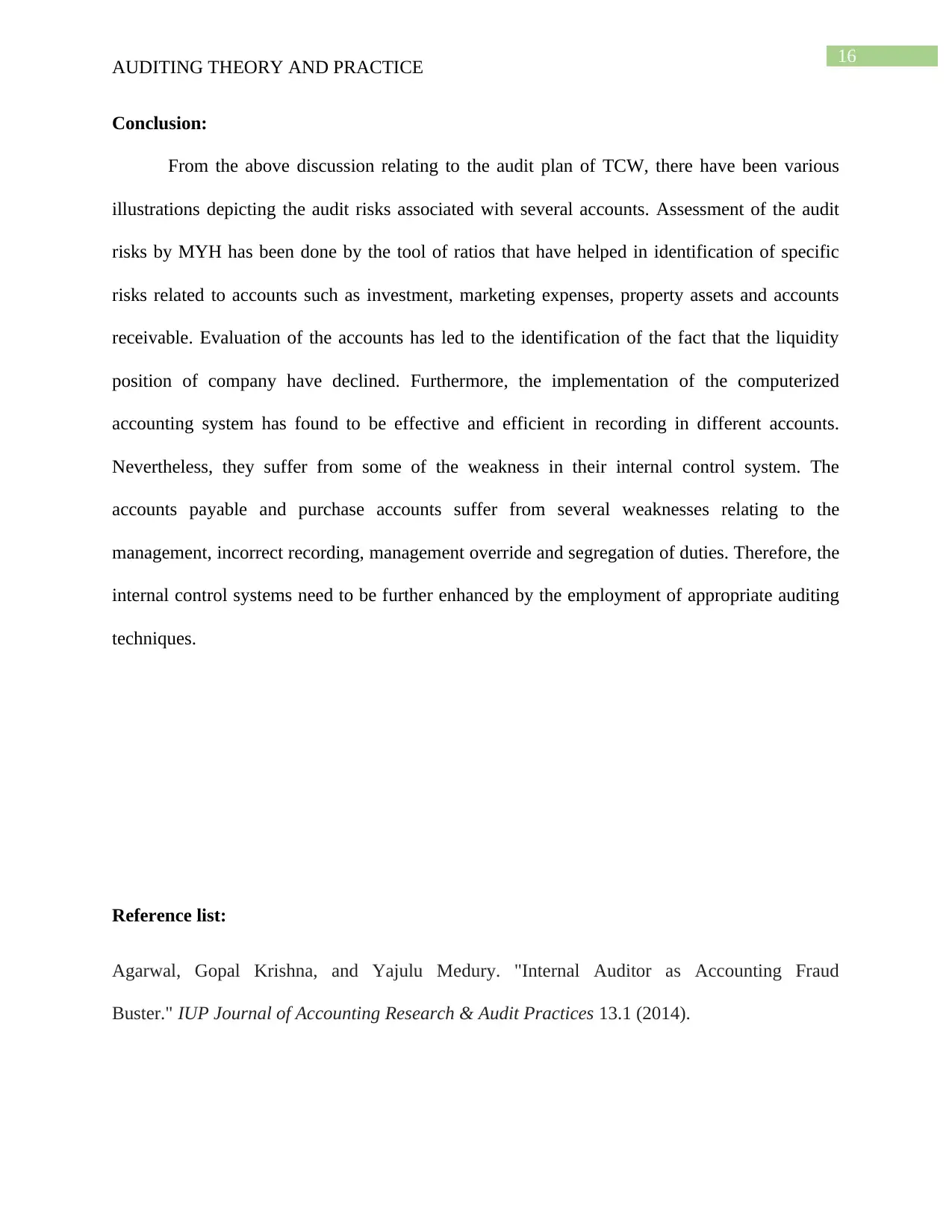
16
AUDITING THEORY AND PRACTICE
Conclusion:
From the above discussion relating to the audit plan of TCW, there have been various
illustrations depicting the audit risks associated with several accounts. Assessment of the audit
risks by MYH has been done by the tool of ratios that have helped in identification of specific
risks related to accounts such as investment, marketing expenses, property assets and accounts
receivable. Evaluation of the accounts has led to the identification of the fact that the liquidity
position of company have declined. Furthermore, the implementation of the computerized
accounting system has found to be effective and efficient in recording in different accounts.
Nevertheless, they suffer from some of the weakness in their internal control system. The
accounts payable and purchase accounts suffer from several weaknesses relating to the
management, incorrect recording, management override and segregation of duties. Therefore, the
internal control systems need to be further enhanced by the employment of appropriate auditing
techniques.
Reference list:
Agarwal, Gopal Krishna, and Yajulu Medury. "Internal Auditor as Accounting Fraud
Buster." IUP Journal of Accounting Research & Audit Practices 13.1 (2014).
AUDITING THEORY AND PRACTICE
Conclusion:
From the above discussion relating to the audit plan of TCW, there have been various
illustrations depicting the audit risks associated with several accounts. Assessment of the audit
risks by MYH has been done by the tool of ratios that have helped in identification of specific
risks related to accounts such as investment, marketing expenses, property assets and accounts
receivable. Evaluation of the accounts has led to the identification of the fact that the liquidity
position of company have declined. Furthermore, the implementation of the computerized
accounting system has found to be effective and efficient in recording in different accounts.
Nevertheless, they suffer from some of the weakness in their internal control system. The
accounts payable and purchase accounts suffer from several weaknesses relating to the
management, incorrect recording, management override and segregation of duties. Therefore, the
internal control systems need to be further enhanced by the employment of appropriate auditing
techniques.
Reference list:
Agarwal, Gopal Krishna, and Yajulu Medury. "Internal Auditor as Accounting Fraud
Buster." IUP Journal of Accounting Research & Audit Practices 13.1 (2014).

17
AUDITING THEORY AND PRACTICE
Albrecht, W. Steve, and Jeffrey L. Hoopes. "Why audits cannot detect all fraud." The CPA
Journal 84.10 (2014): 12.
Albring, Susan M., Randal J. Elder, and Xiaolu Xu. "Unexpected fees and the prediction of
material weaknesses in internal control over financial reporting." Journal of Accounting,
Auditing & Finance (2016): 0148558X16662585.
Amel-Zadeh, Amir, and Yuan Zhang. "The economic consequences of financial restatements:
Evidence from the market for corporate control." The Accounting Review 90.1 (2014): 1-29.
Bell, Timothy B., Monika Causholli, and W. Robert Knechel. "Audit firm tenure, non‐audit
services, and internal assessments of audit quality." Journal of Accounting Research53.3 (2015):
461-509.
Brown-Liburd, Helen, Hussein Issa, and Danielle Lombardi. "Behavioral implications of Big
Data's impact on audit judgment and decision making and future research
directions." Accounting Horizons 29.2 (2015): 451-468.
Cao, Min, Roman Chychyla, and Trevor Stewart. "Big Data analytics in financial statement
audits." Accounting Horizons29.2 (2015): 423-429.
Cheng, Qiang, Beng Wee Goh, and Jae B. Kim. "Internal control and operational
efficiency." Contemporary Accounting Research 35.2 (2018): 1102-1139.
Commerford, Benjamin P., et al. "Real earnings management: A threat to auditor
comfort?." Auditing: A Journal of Practice & Theory 35.4 (2016): 39-56.
Dichev, Ilia, et al. "The misrepresentation of earnings." Financial Analysts Journal 72.1 (2016):
22-35.
AUDITING THEORY AND PRACTICE
Albrecht, W. Steve, and Jeffrey L. Hoopes. "Why audits cannot detect all fraud." The CPA
Journal 84.10 (2014): 12.
Albring, Susan M., Randal J. Elder, and Xiaolu Xu. "Unexpected fees and the prediction of
material weaknesses in internal control over financial reporting." Journal of Accounting,
Auditing & Finance (2016): 0148558X16662585.
Amel-Zadeh, Amir, and Yuan Zhang. "The economic consequences of financial restatements:
Evidence from the market for corporate control." The Accounting Review 90.1 (2014): 1-29.
Bell, Timothy B., Monika Causholli, and W. Robert Knechel. "Audit firm tenure, non‐audit
services, and internal assessments of audit quality." Journal of Accounting Research53.3 (2015):
461-509.
Brown-Liburd, Helen, Hussein Issa, and Danielle Lombardi. "Behavioral implications of Big
Data's impact on audit judgment and decision making and future research
directions." Accounting Horizons 29.2 (2015): 451-468.
Cao, Min, Roman Chychyla, and Trevor Stewart. "Big Data analytics in financial statement
audits." Accounting Horizons29.2 (2015): 423-429.
Cheng, Qiang, Beng Wee Goh, and Jae B. Kim. "Internal control and operational
efficiency." Contemporary Accounting Research 35.2 (2018): 1102-1139.
Commerford, Benjamin P., et al. "Real earnings management: A threat to auditor
comfort?." Auditing: A Journal of Practice & Theory 35.4 (2016): 39-56.
Dichev, Ilia, et al. "The misrepresentation of earnings." Financial Analysts Journal 72.1 (2016):
22-35.
You're viewing a preview
Unlock full access by subscribing today!
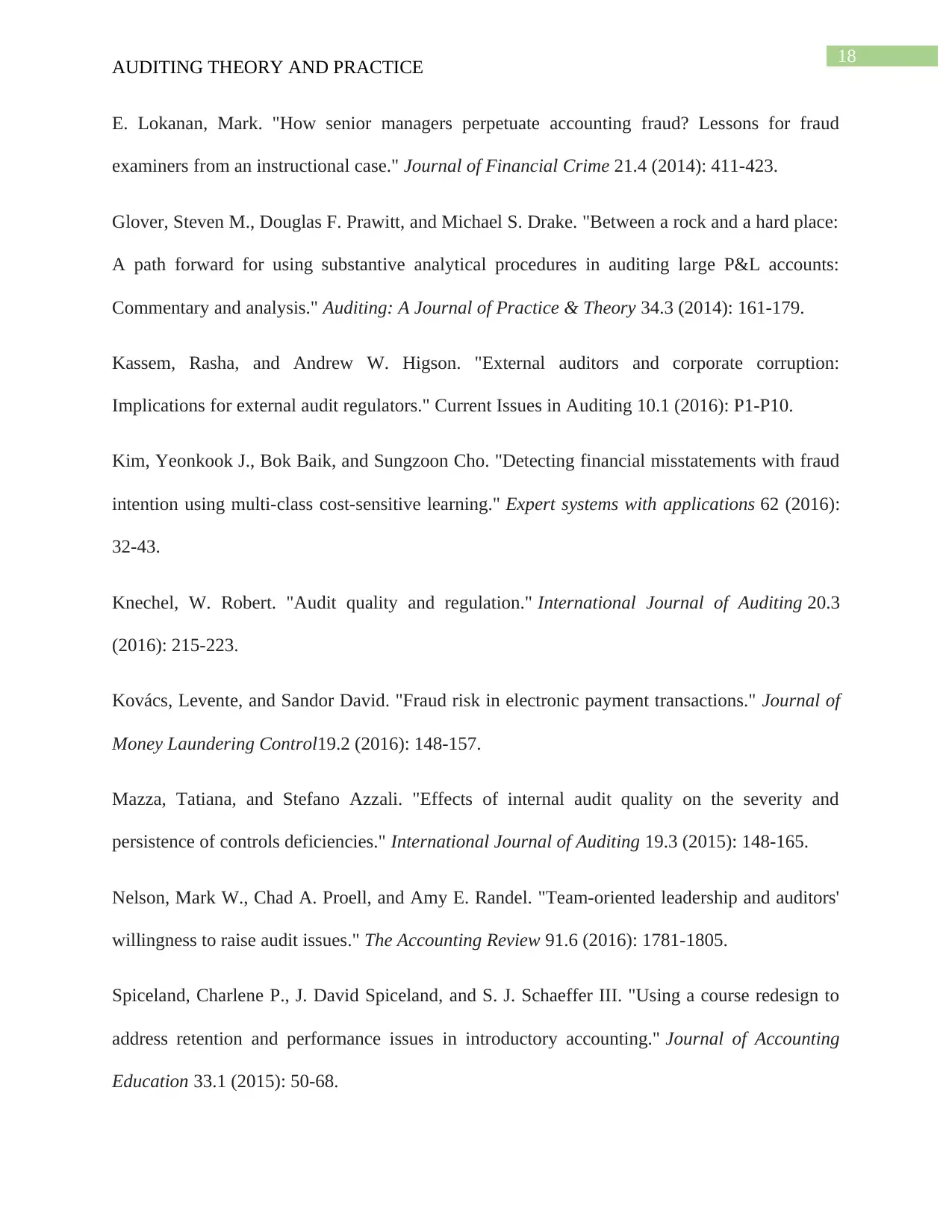
18
AUDITING THEORY AND PRACTICE
E. Lokanan, Mark. "How senior managers perpetuate accounting fraud? Lessons for fraud
examiners from an instructional case." Journal of Financial Crime 21.4 (2014): 411-423.
Glover, Steven M., Douglas F. Prawitt, and Michael S. Drake. "Between a rock and a hard place:
A path forward for using substantive analytical procedures in auditing large P&L accounts:
Commentary and analysis." Auditing: A Journal of Practice & Theory 34.3 (2014): 161-179.
Kassem, Rasha, and Andrew W. Higson. "External auditors and corporate corruption:
Implications for external audit regulators." Current Issues in Auditing 10.1 (2016): P1-P10.
Kim, Yeonkook J., Bok Baik, and Sungzoon Cho. "Detecting financial misstatements with fraud
intention using multi-class cost-sensitive learning." Expert systems with applications 62 (2016):
32-43.
Knechel, W. Robert. "Audit quality and regulation." International Journal of Auditing 20.3
(2016): 215-223.
Kovács, Levente, and Sandor David. "Fraud risk in electronic payment transactions." Journal of
Money Laundering Control19.2 (2016): 148-157.
Mazza, Tatiana, and Stefano Azzali. "Effects of internal audit quality on the severity and
persistence of controls deficiencies." International Journal of Auditing 19.3 (2015): 148-165.
Nelson, Mark W., Chad A. Proell, and Amy E. Randel. "Team-oriented leadership and auditors'
willingness to raise audit issues." The Accounting Review 91.6 (2016): 1781-1805.
Spiceland, Charlene P., J. David Spiceland, and S. J. Schaeffer III. "Using a course redesign to
address retention and performance issues in introductory accounting." Journal of Accounting
Education 33.1 (2015): 50-68.
AUDITING THEORY AND PRACTICE
E. Lokanan, Mark. "How senior managers perpetuate accounting fraud? Lessons for fraud
examiners from an instructional case." Journal of Financial Crime 21.4 (2014): 411-423.
Glover, Steven M., Douglas F. Prawitt, and Michael S. Drake. "Between a rock and a hard place:
A path forward for using substantive analytical procedures in auditing large P&L accounts:
Commentary and analysis." Auditing: A Journal of Practice & Theory 34.3 (2014): 161-179.
Kassem, Rasha, and Andrew W. Higson. "External auditors and corporate corruption:
Implications for external audit regulators." Current Issues in Auditing 10.1 (2016): P1-P10.
Kim, Yeonkook J., Bok Baik, and Sungzoon Cho. "Detecting financial misstatements with fraud
intention using multi-class cost-sensitive learning." Expert systems with applications 62 (2016):
32-43.
Knechel, W. Robert. "Audit quality and regulation." International Journal of Auditing 20.3
(2016): 215-223.
Kovács, Levente, and Sandor David. "Fraud risk in electronic payment transactions." Journal of
Money Laundering Control19.2 (2016): 148-157.
Mazza, Tatiana, and Stefano Azzali. "Effects of internal audit quality on the severity and
persistence of controls deficiencies." International Journal of Auditing 19.3 (2015): 148-165.
Nelson, Mark W., Chad A. Proell, and Amy E. Randel. "Team-oriented leadership and auditors'
willingness to raise audit issues." The Accounting Review 91.6 (2016): 1781-1805.
Spiceland, Charlene P., J. David Spiceland, and S. J. Schaeffer III. "Using a course redesign to
address retention and performance issues in introductory accounting." Journal of Accounting
Education 33.1 (2015): 50-68.
Paraphrase This Document
Need a fresh take? Get an instant paraphrase of this document with our AI Paraphraser
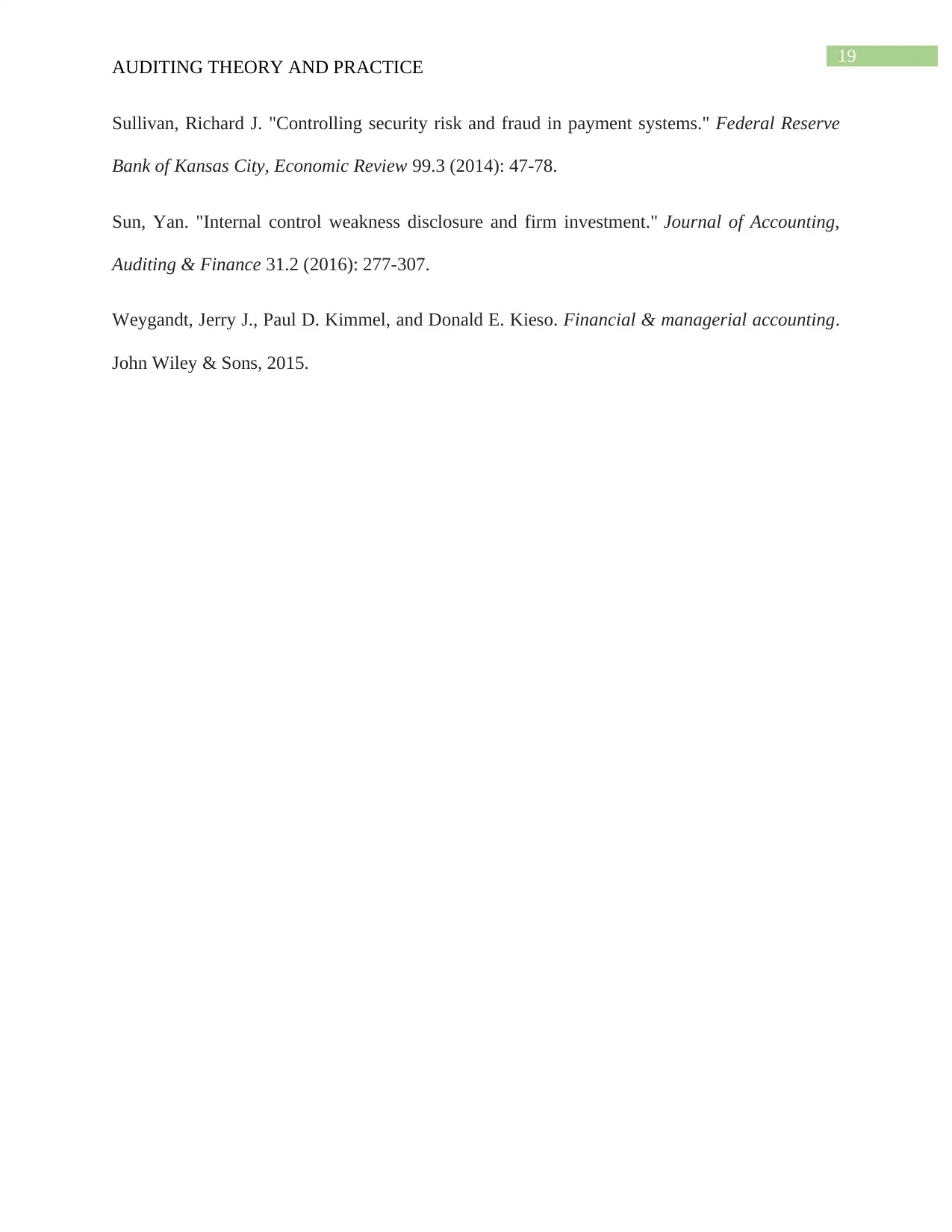
19
AUDITING THEORY AND PRACTICE
Sullivan, Richard J. "Controlling security risk and fraud in payment systems." Federal Reserve
Bank of Kansas City, Economic Review 99.3 (2014): 47-78.
Sun, Yan. "Internal control weakness disclosure and firm investment." Journal of Accounting,
Auditing & Finance 31.2 (2016): 277-307.
Weygandt, Jerry J., Paul D. Kimmel, and Donald E. Kieso. Financial & managerial accounting.
John Wiley & Sons, 2015.
AUDITING THEORY AND PRACTICE
Sullivan, Richard J. "Controlling security risk and fraud in payment systems." Federal Reserve
Bank of Kansas City, Economic Review 99.3 (2014): 47-78.
Sun, Yan. "Internal control weakness disclosure and firm investment." Journal of Accounting,
Auditing & Finance 31.2 (2016): 277-307.
Weygandt, Jerry J., Paul D. Kimmel, and Donald E. Kieso. Financial & managerial accounting.
John Wiley & Sons, 2015.
1 out of 20
Related Documents
Your All-in-One AI-Powered Toolkit for Academic Success.
+13062052269
info@desklib.com
Available 24*7 on WhatsApp / Email
![[object Object]](/_next/static/media/star-bottom.7253800d.svg)
Unlock your academic potential
© 2024 | Zucol Services PVT LTD | All rights reserved.




